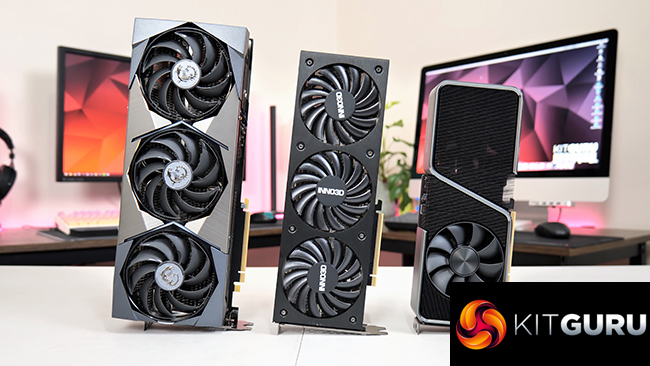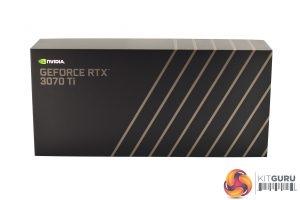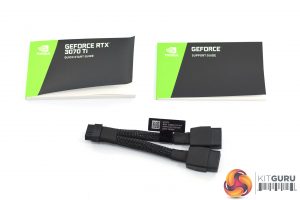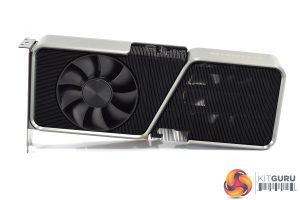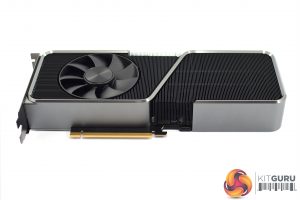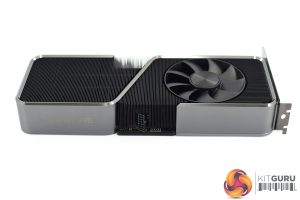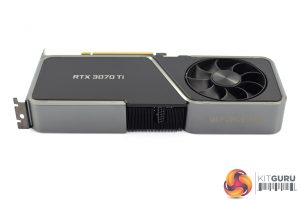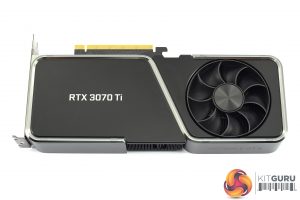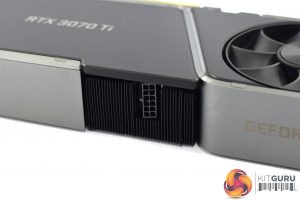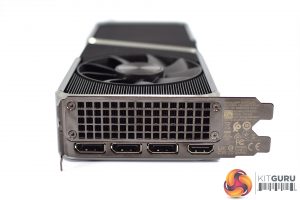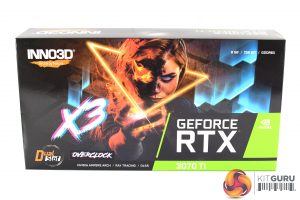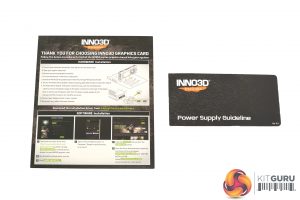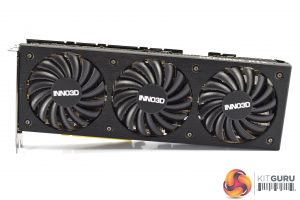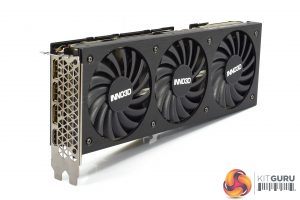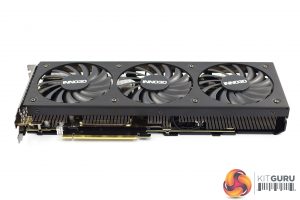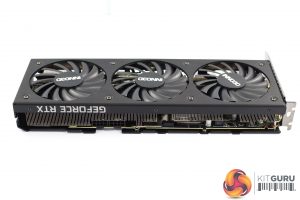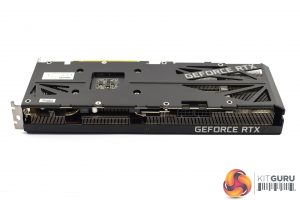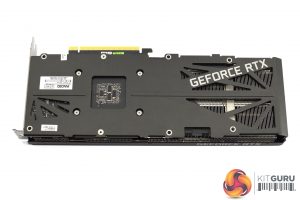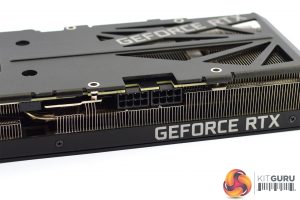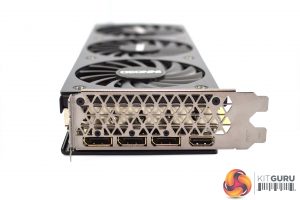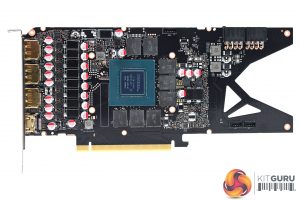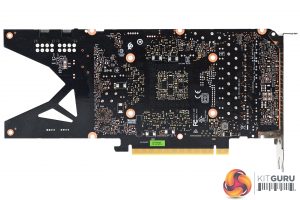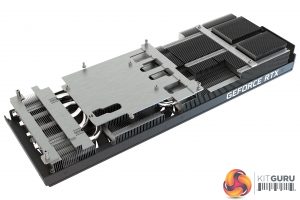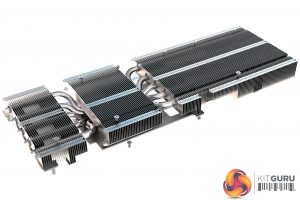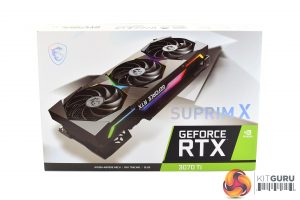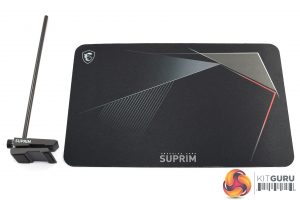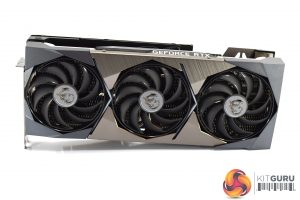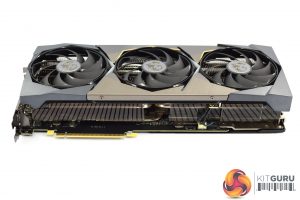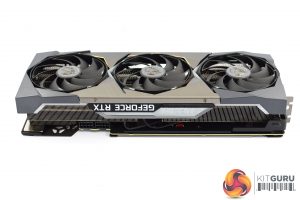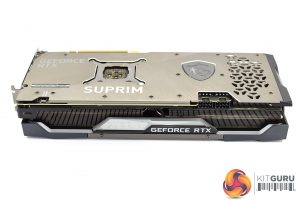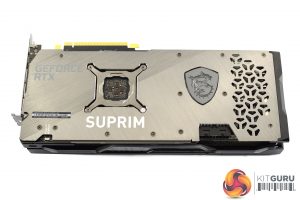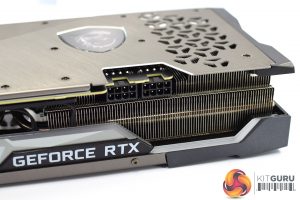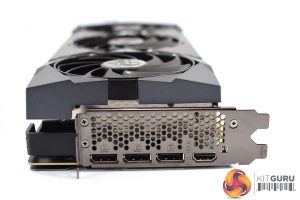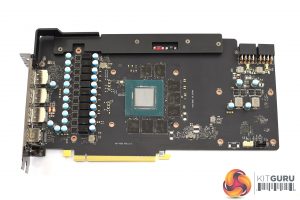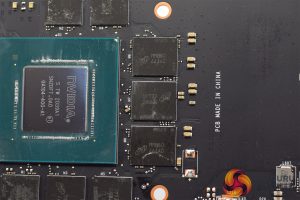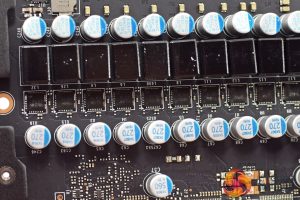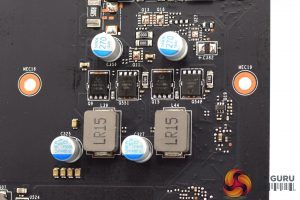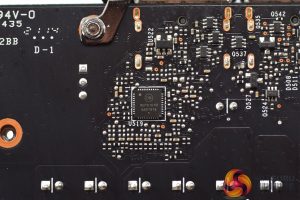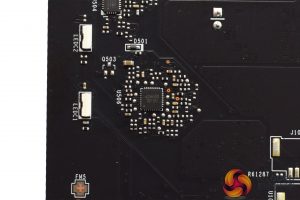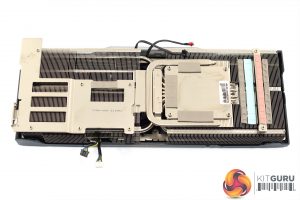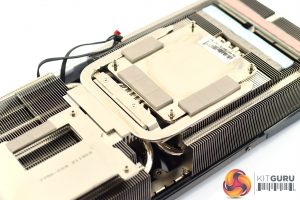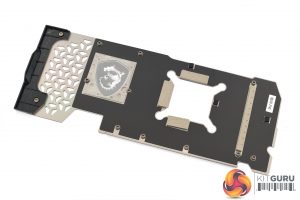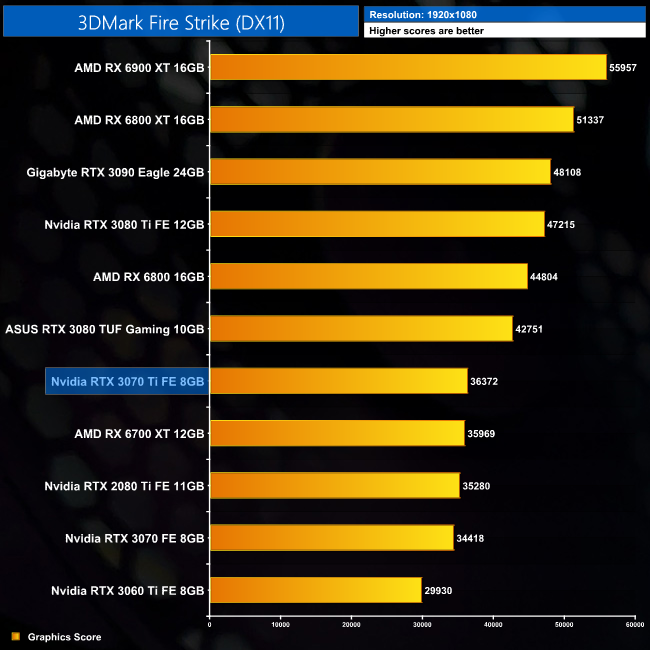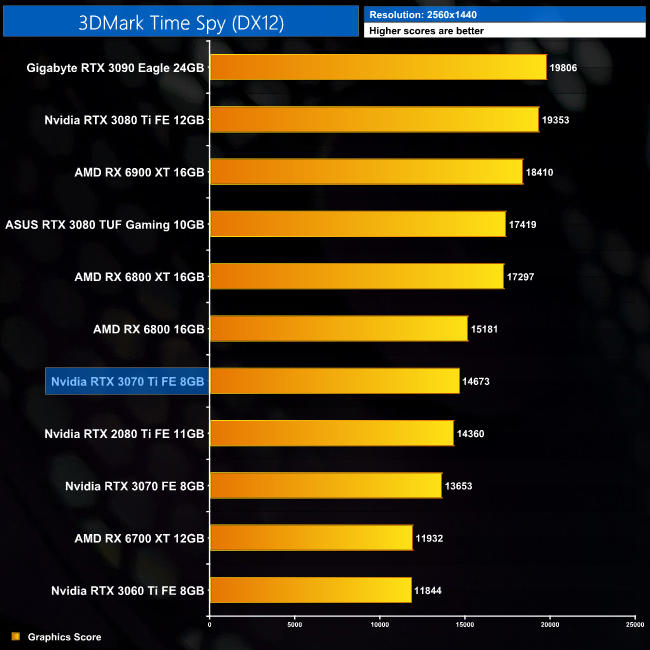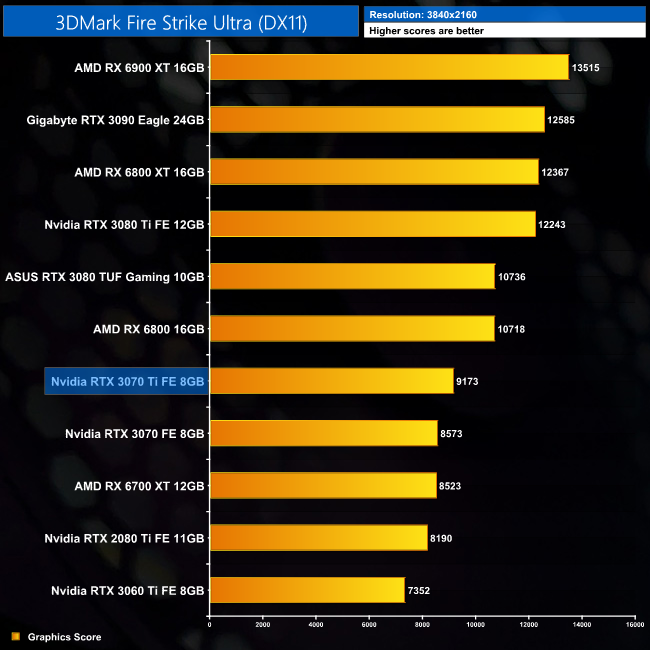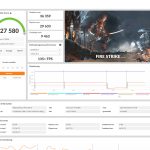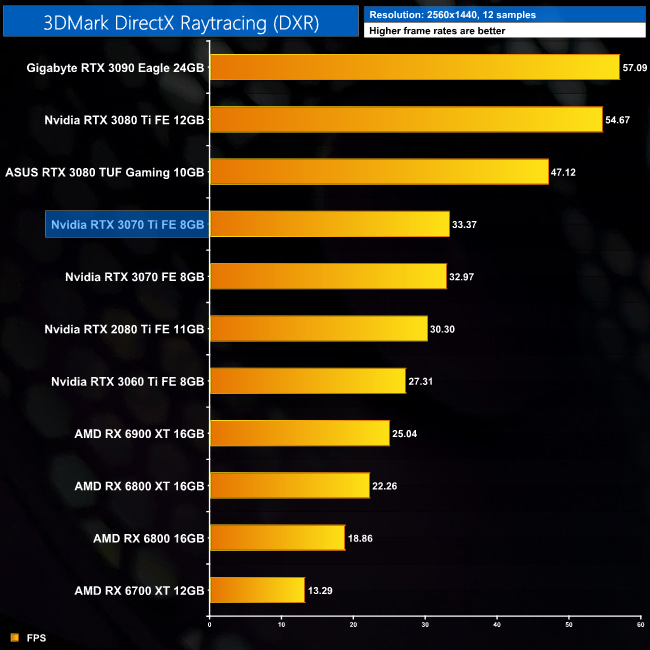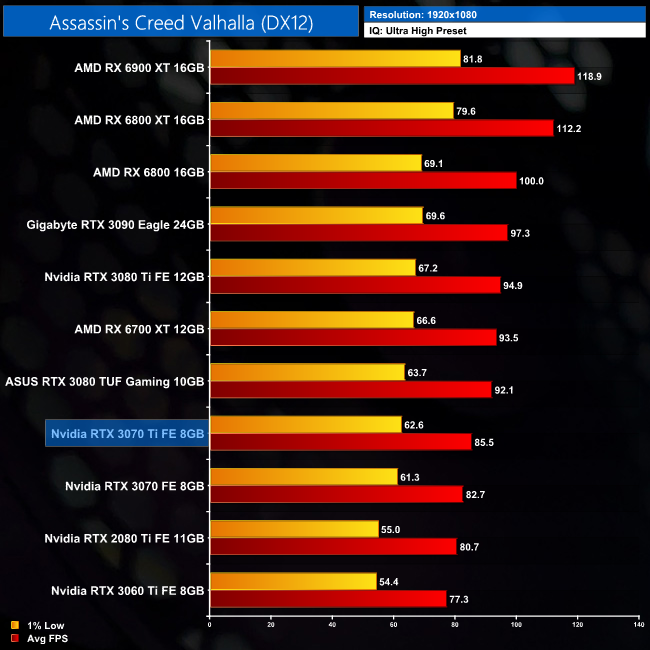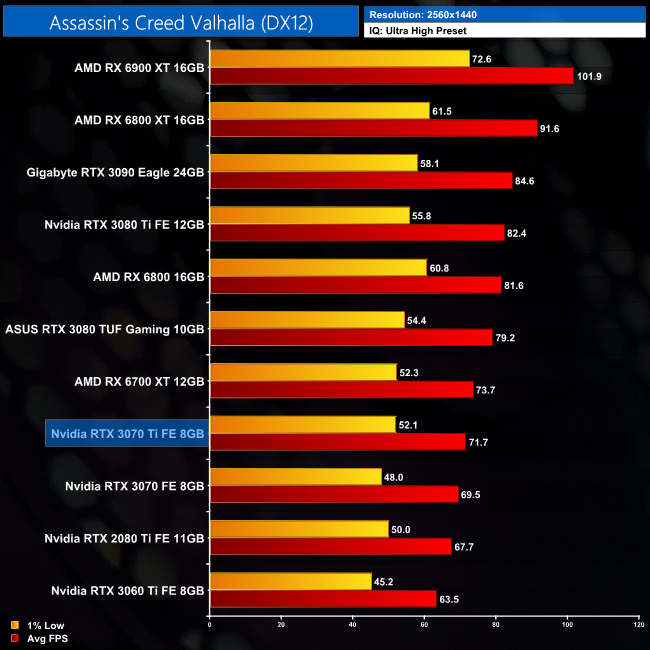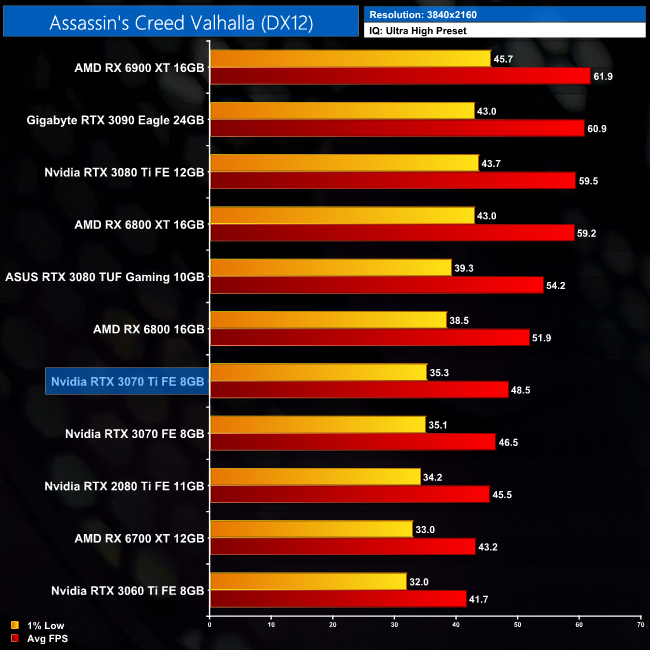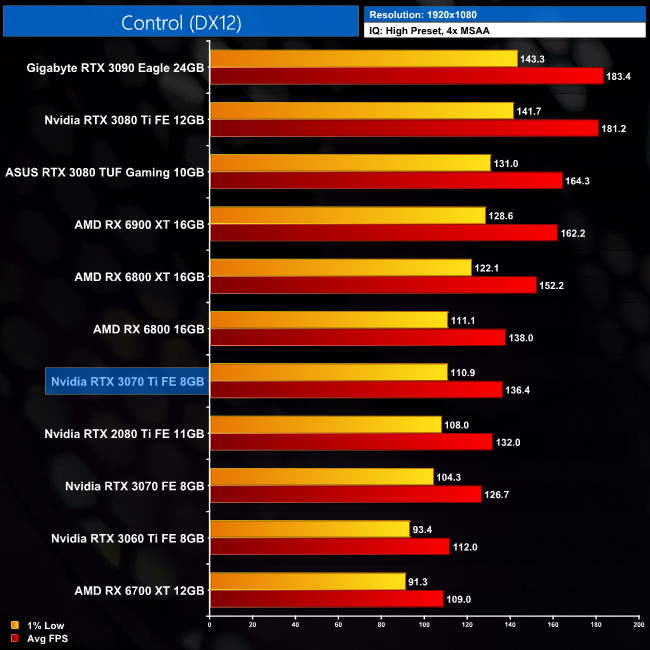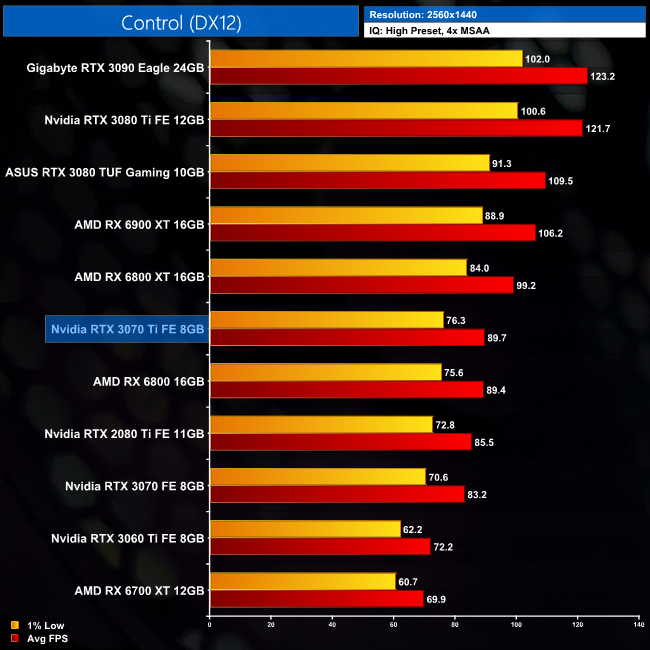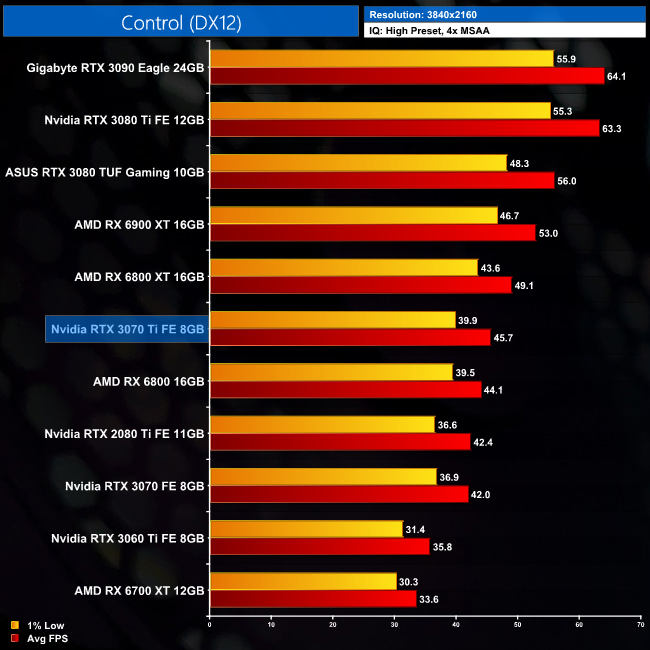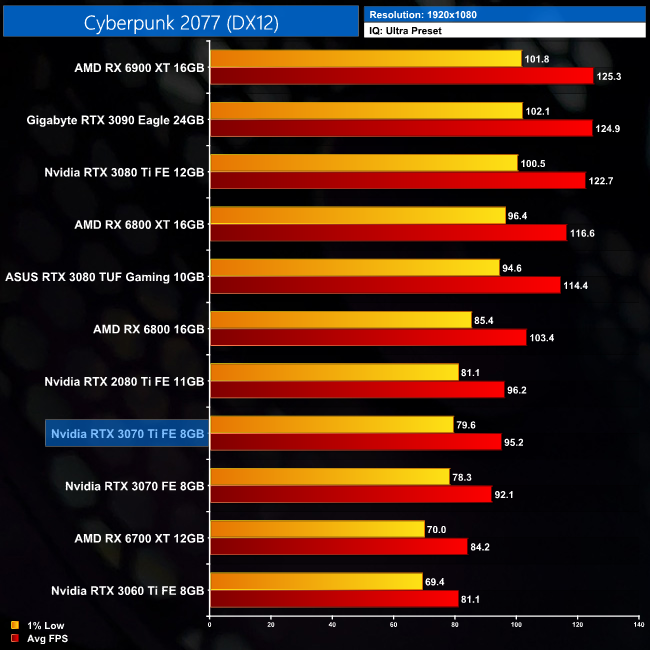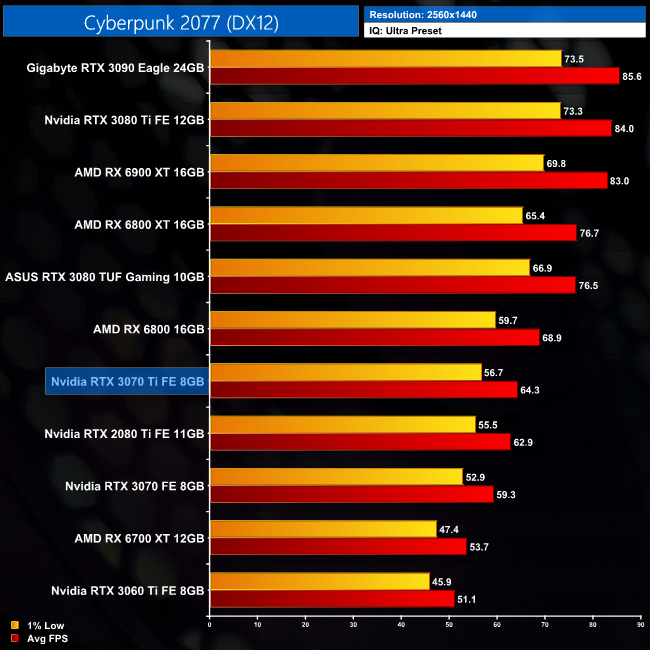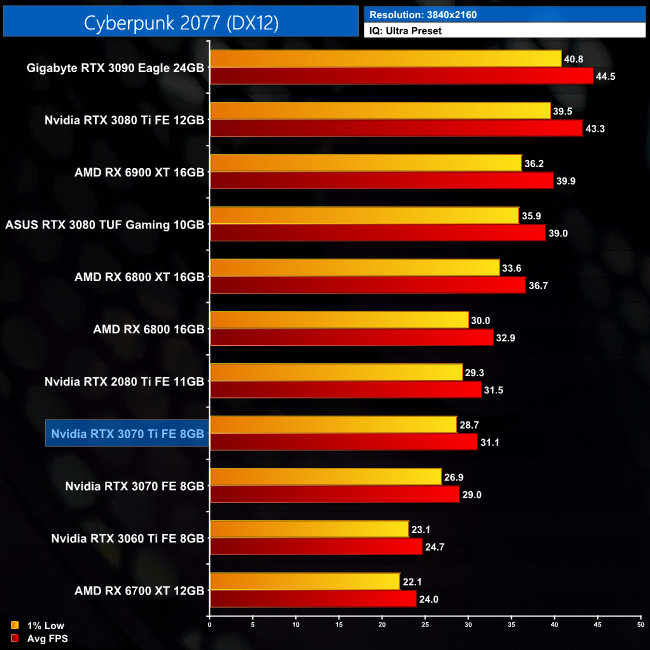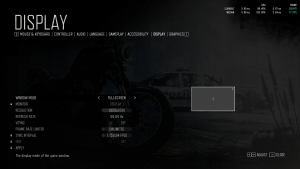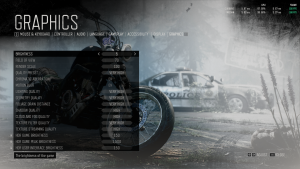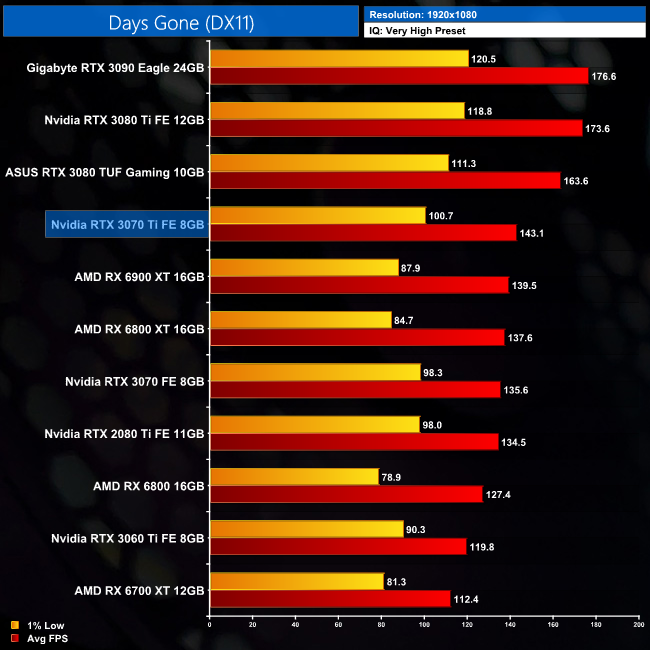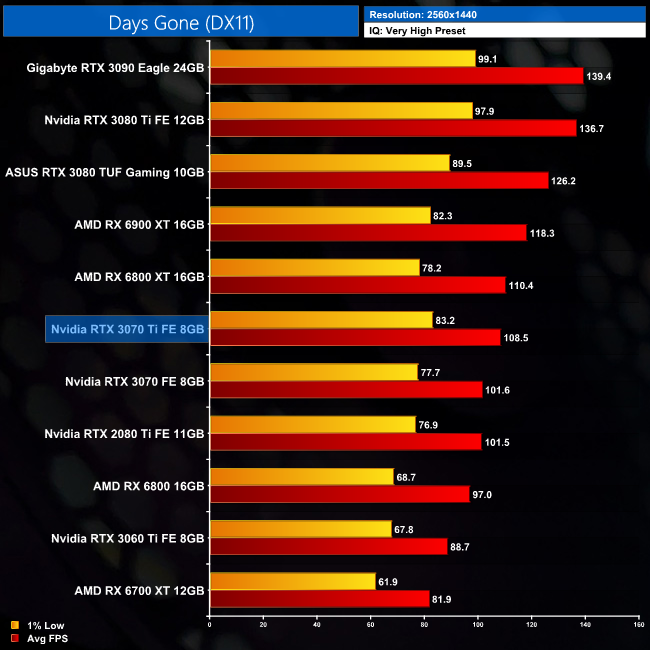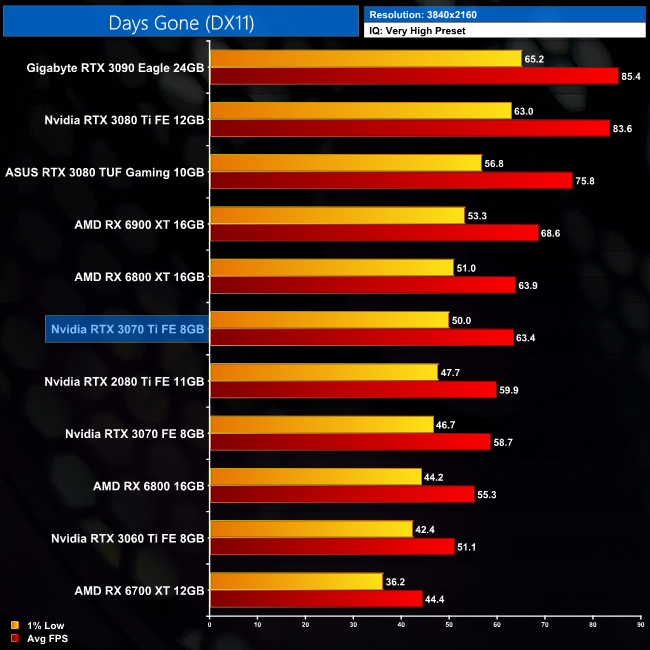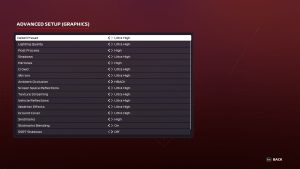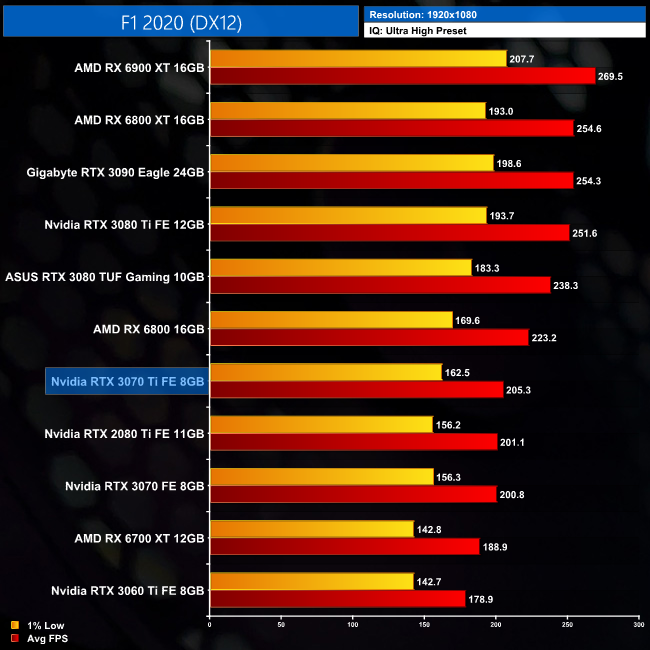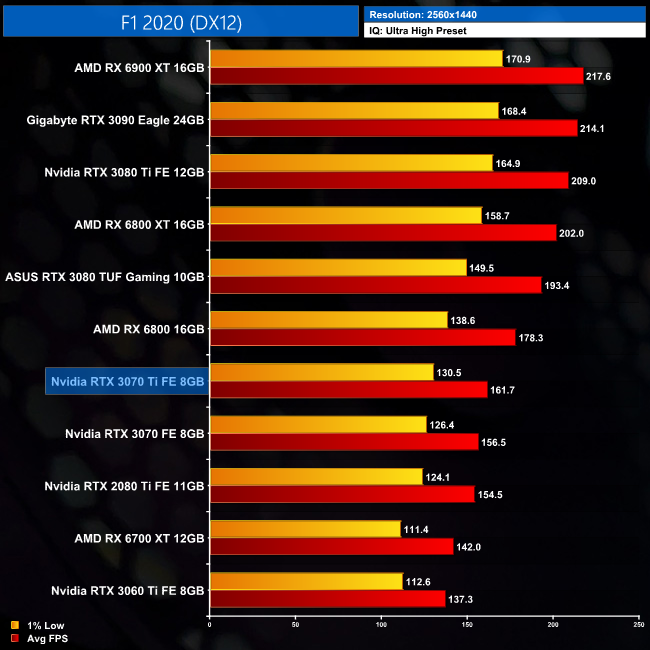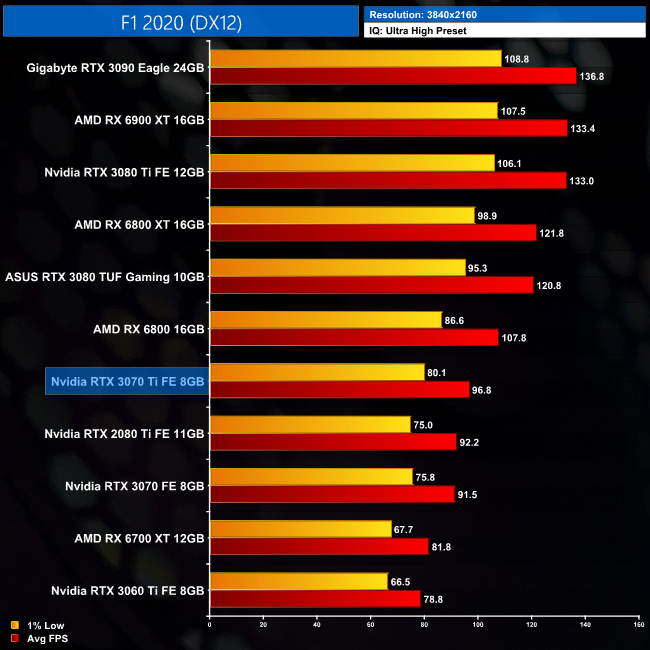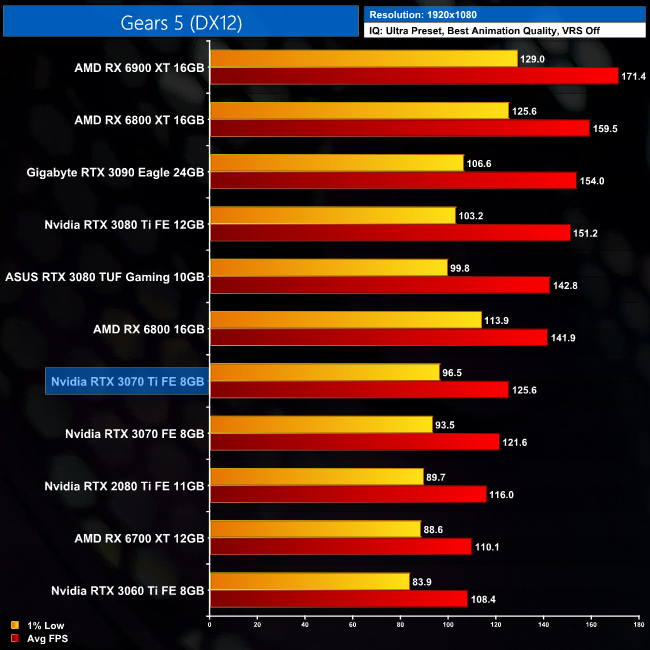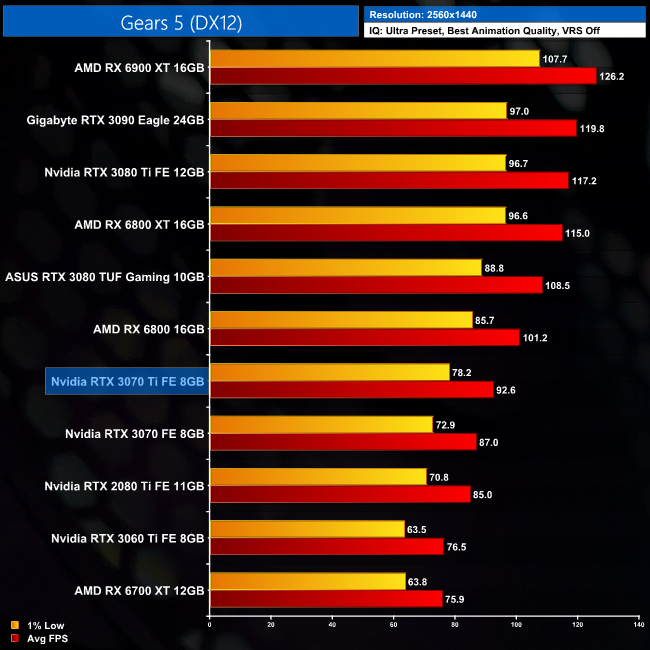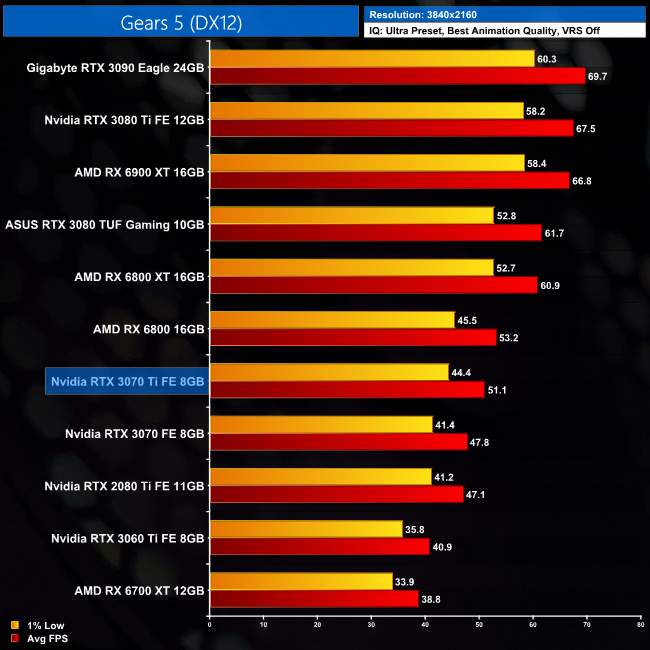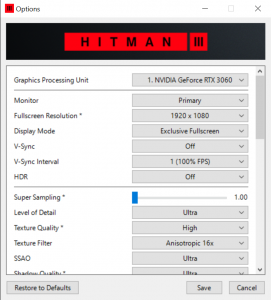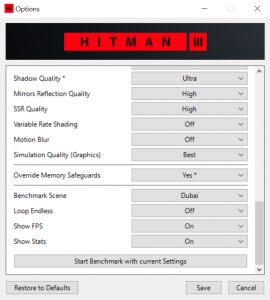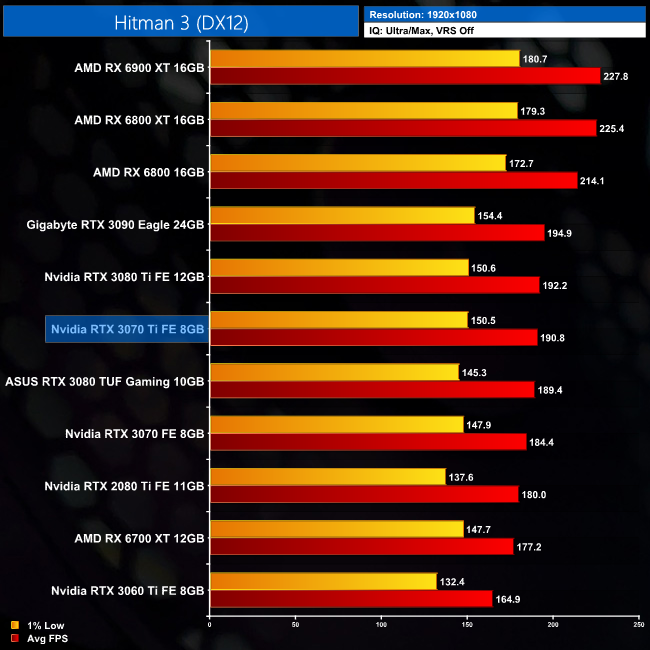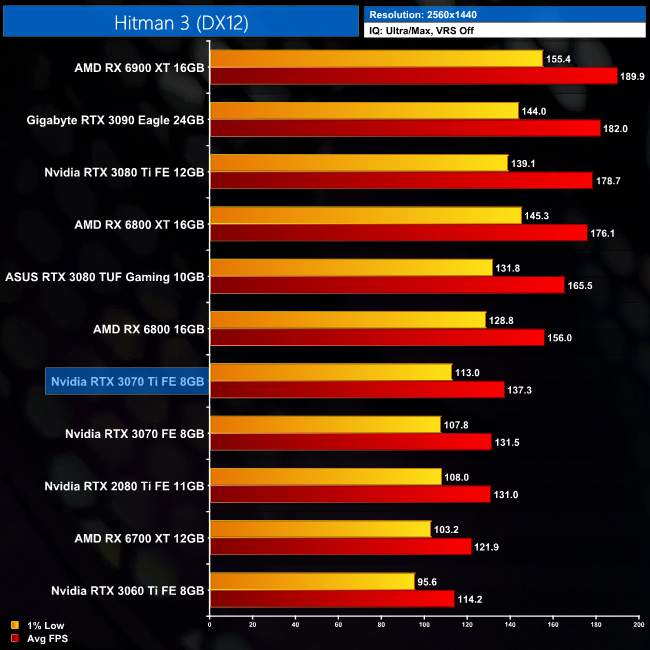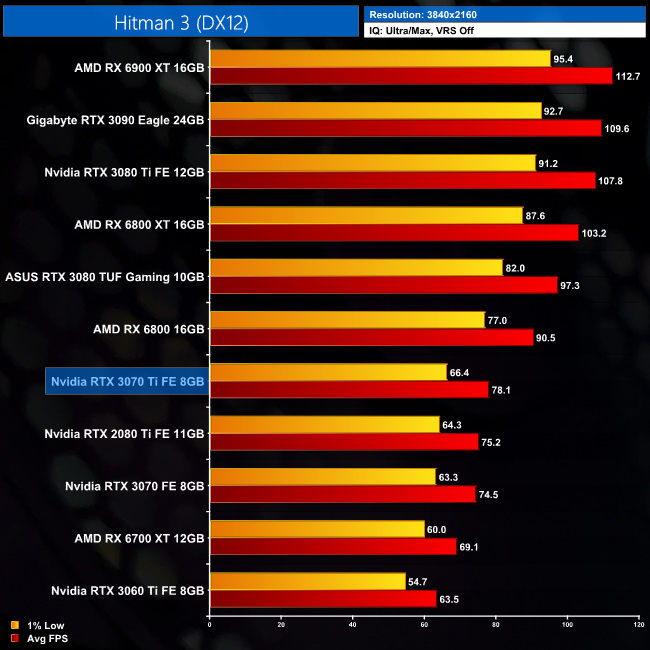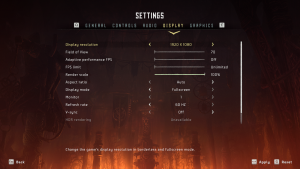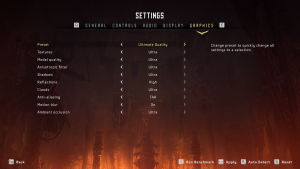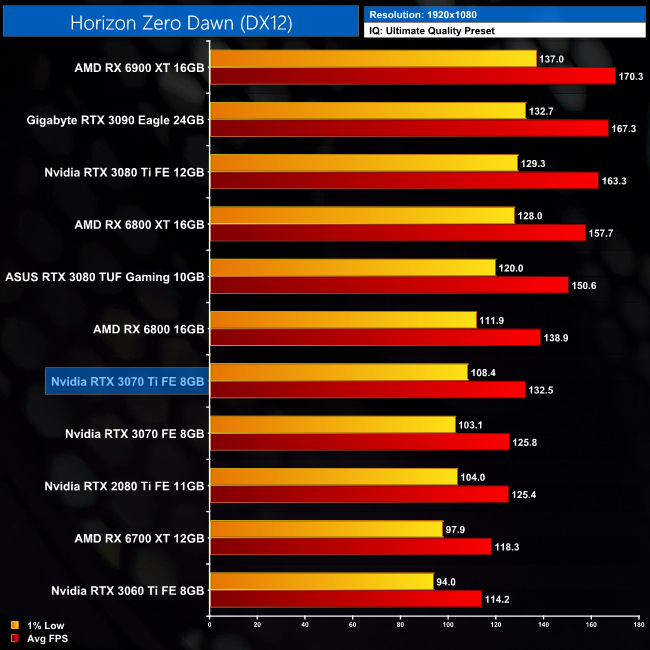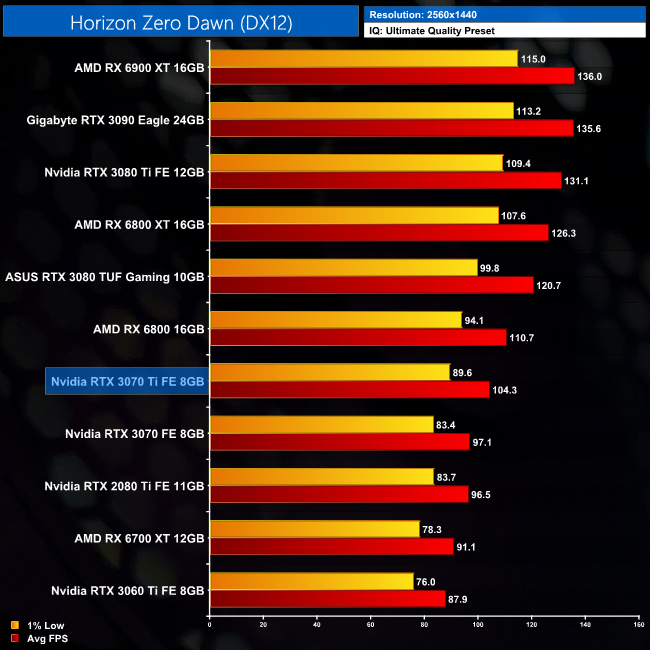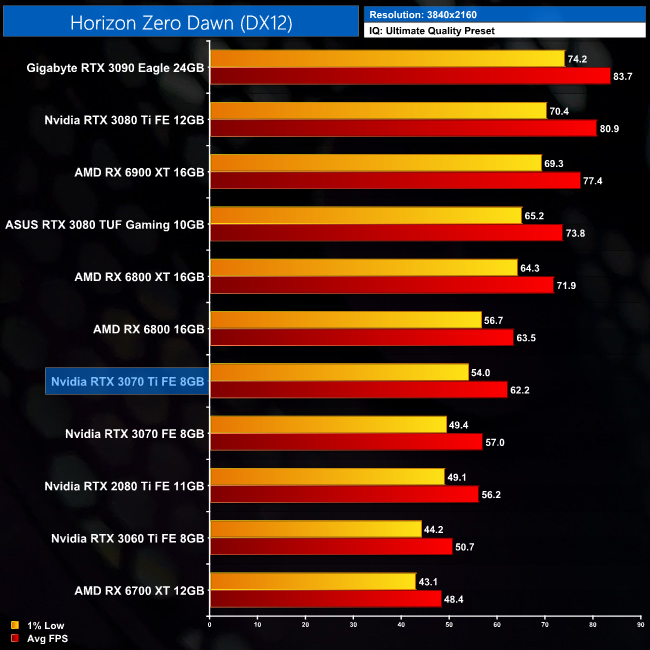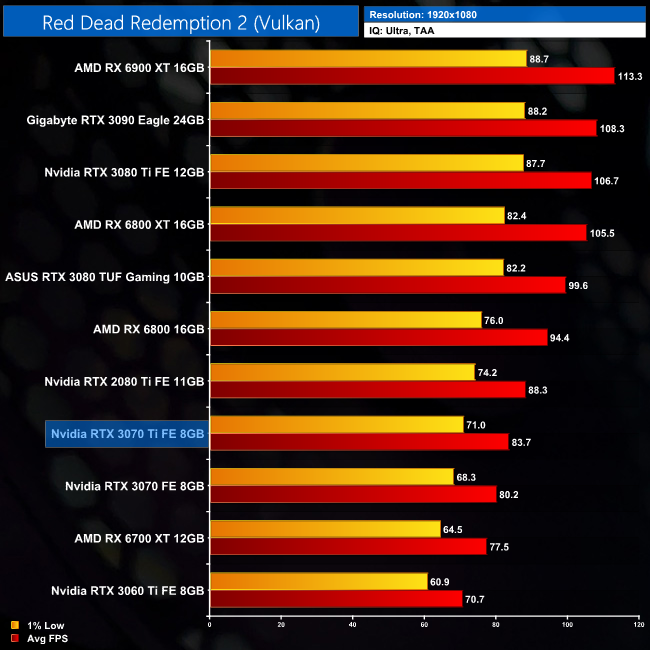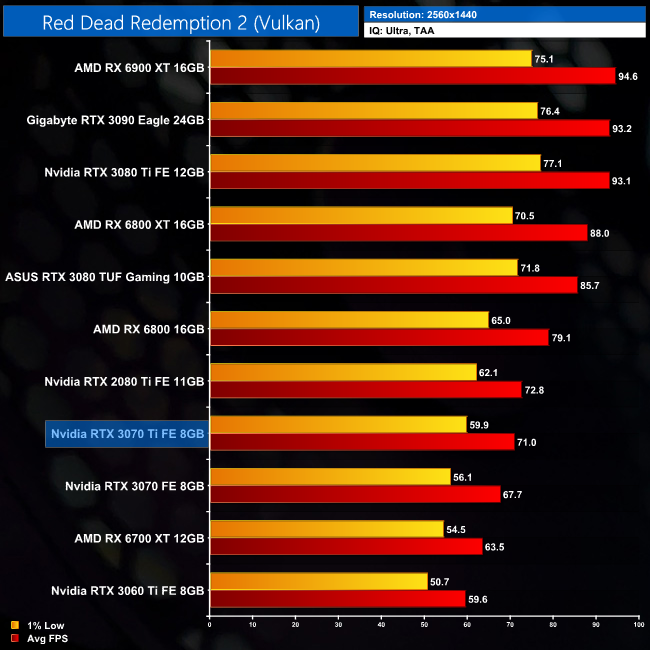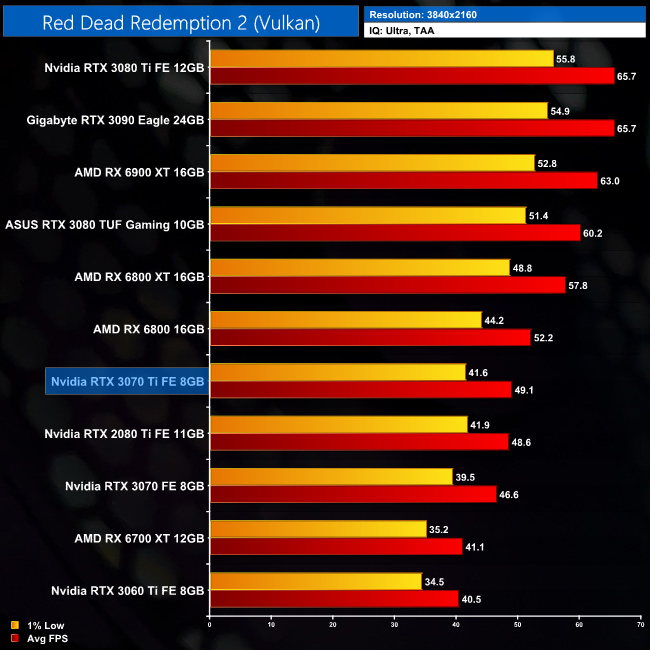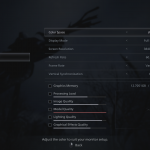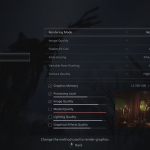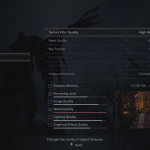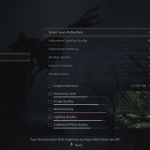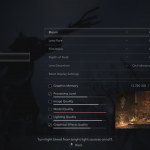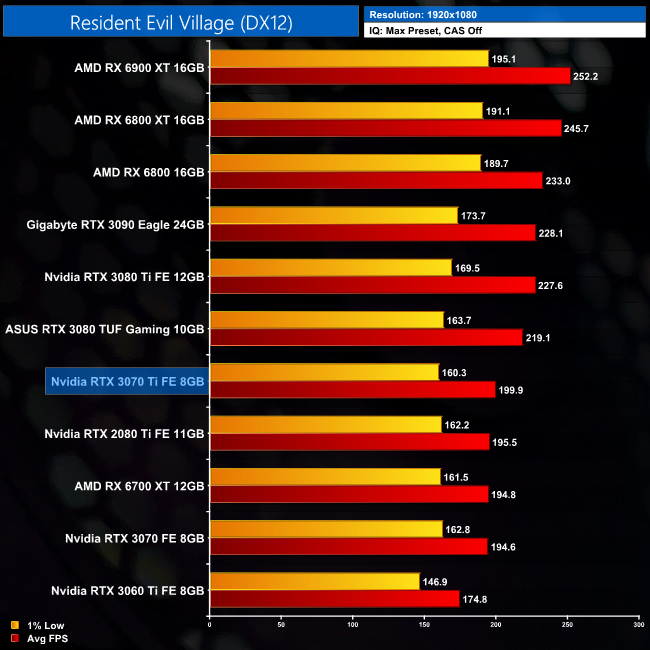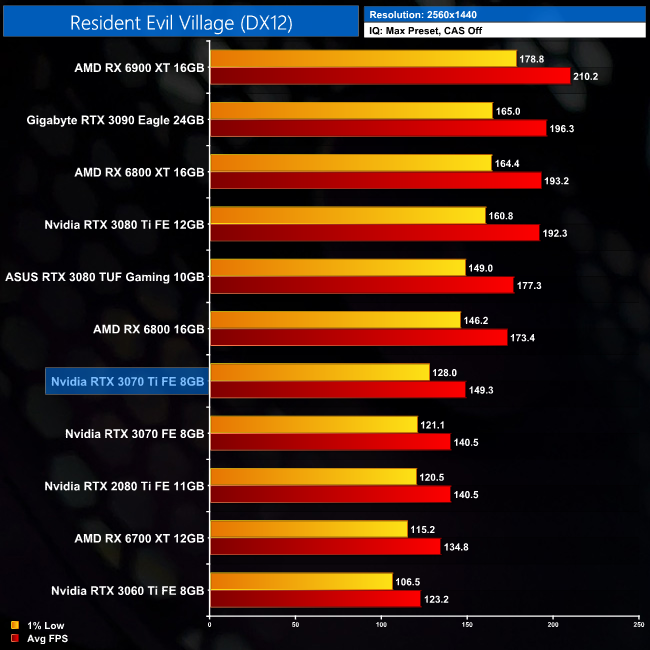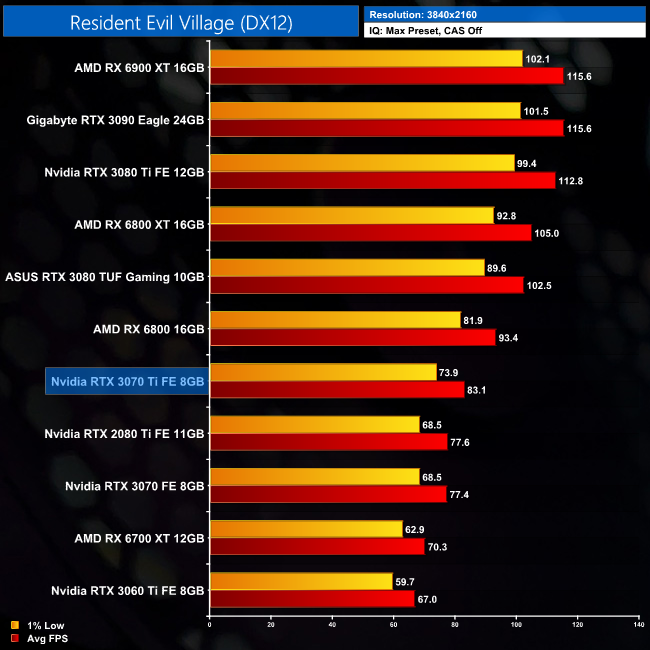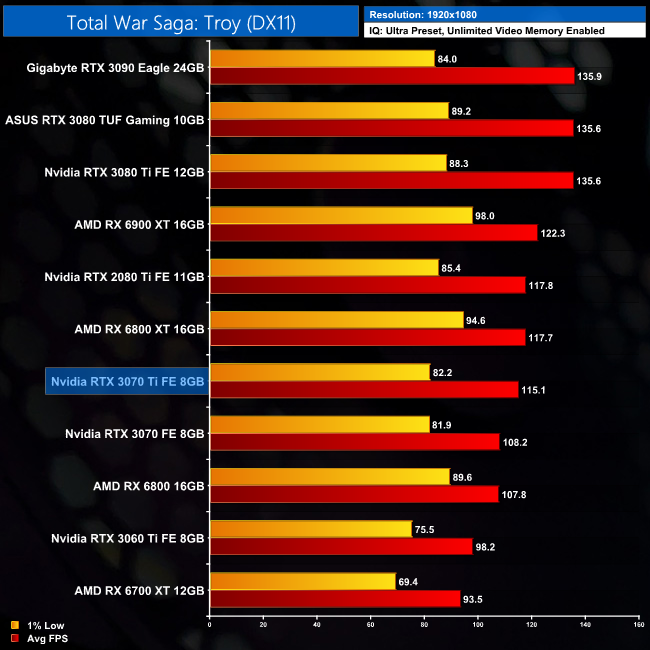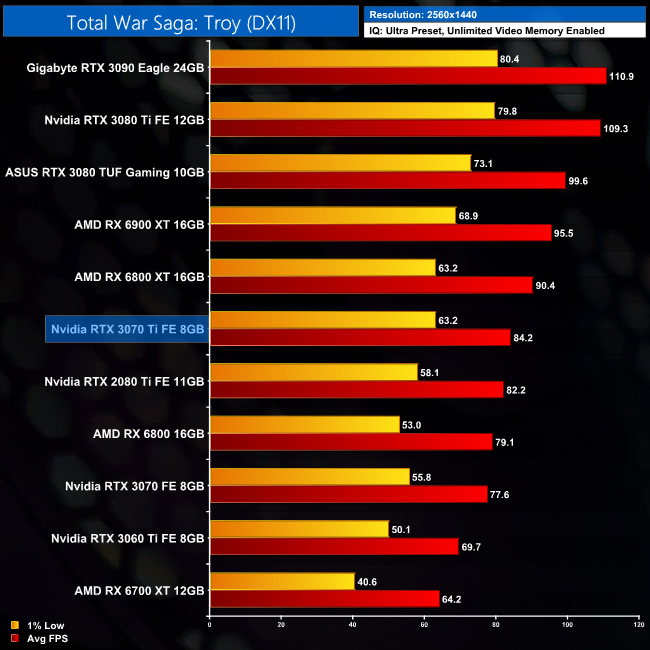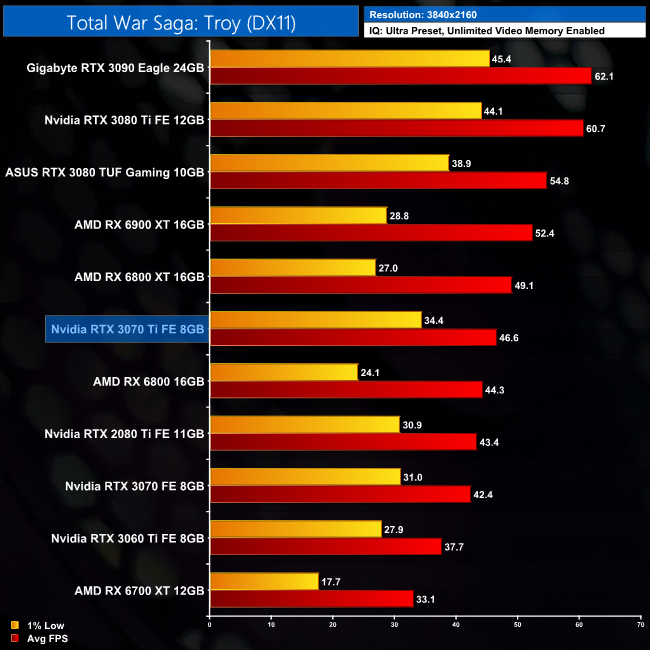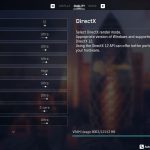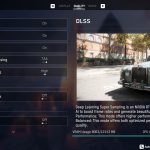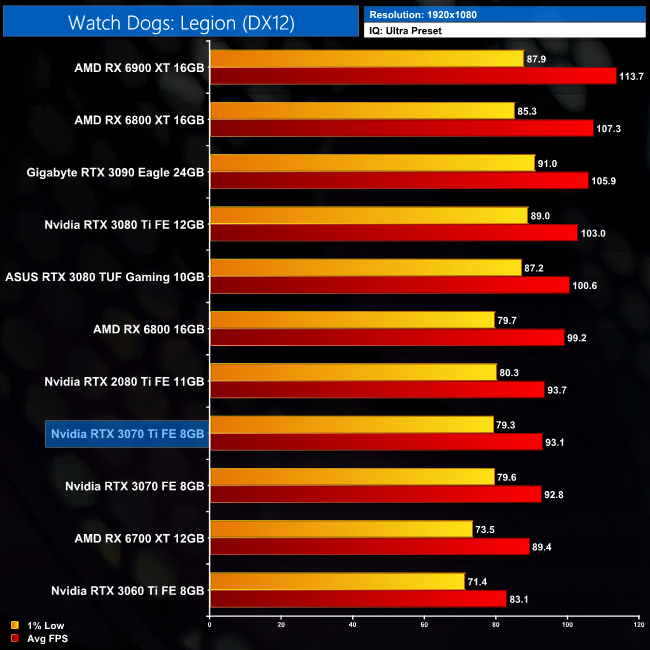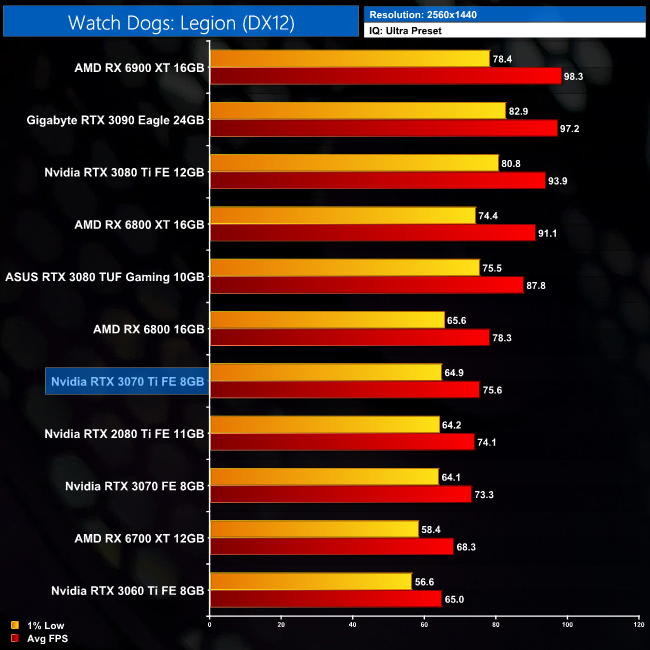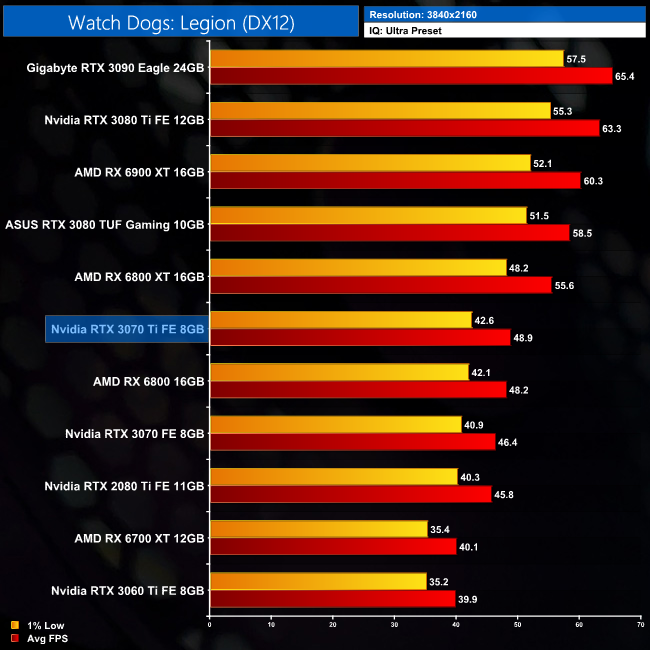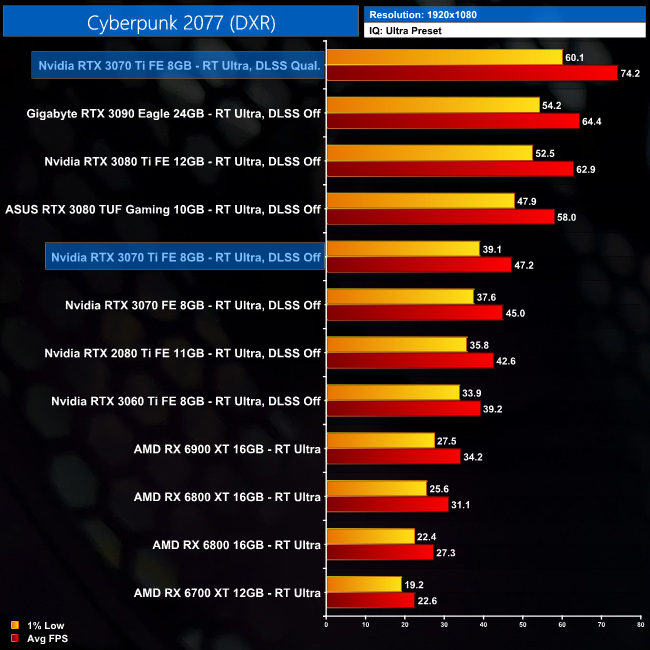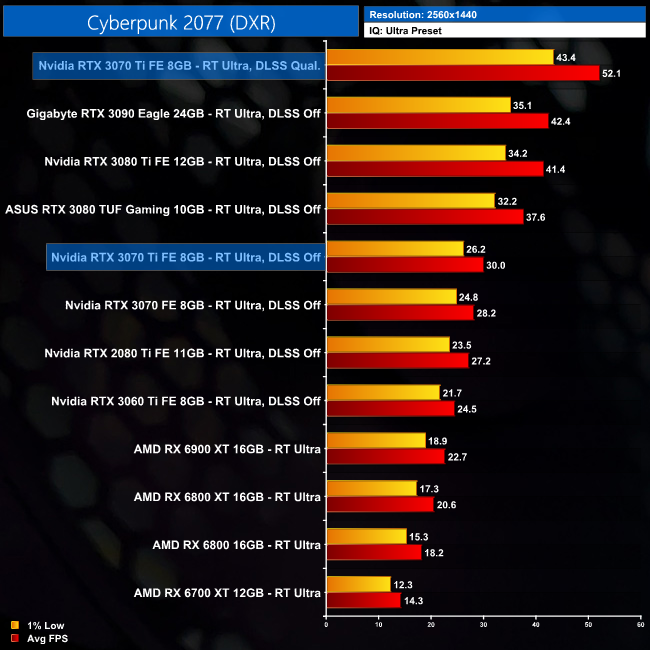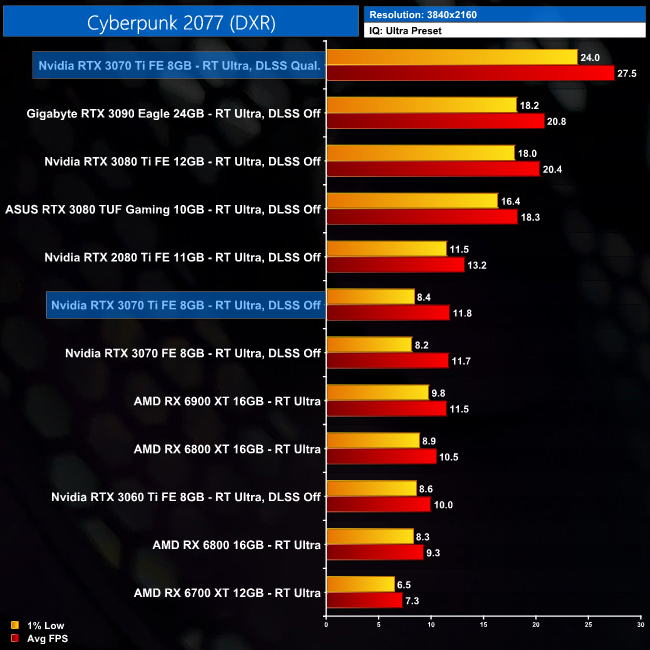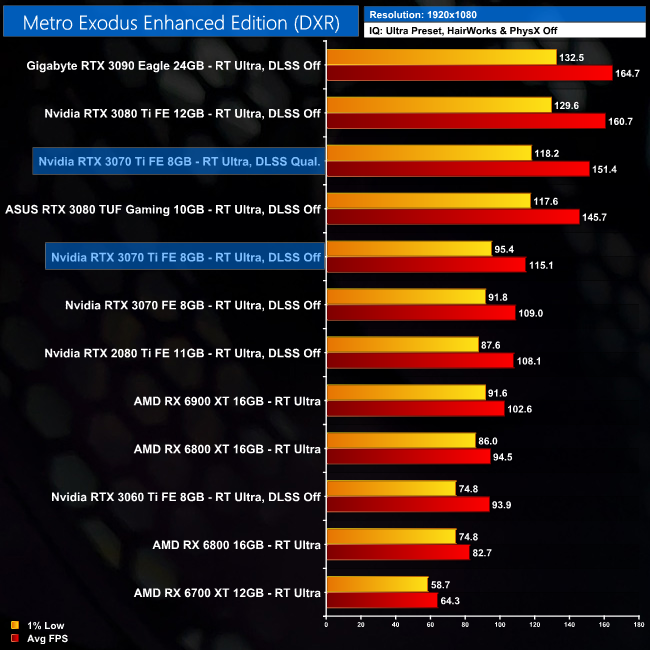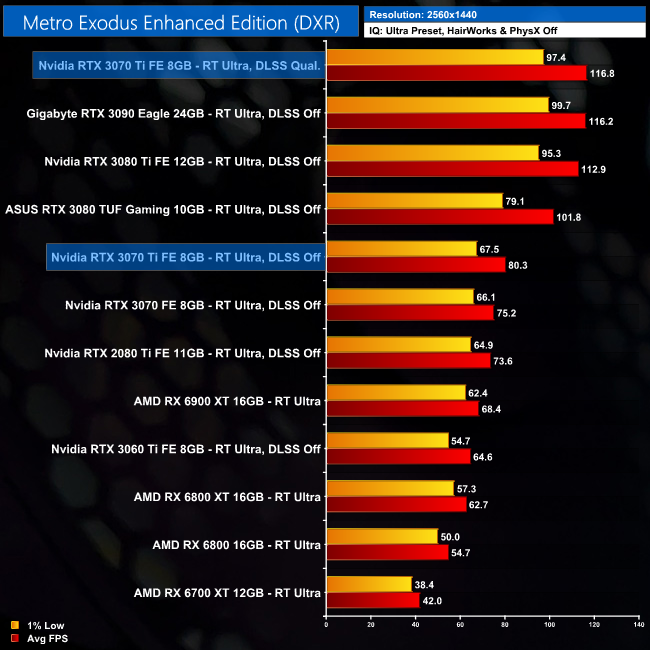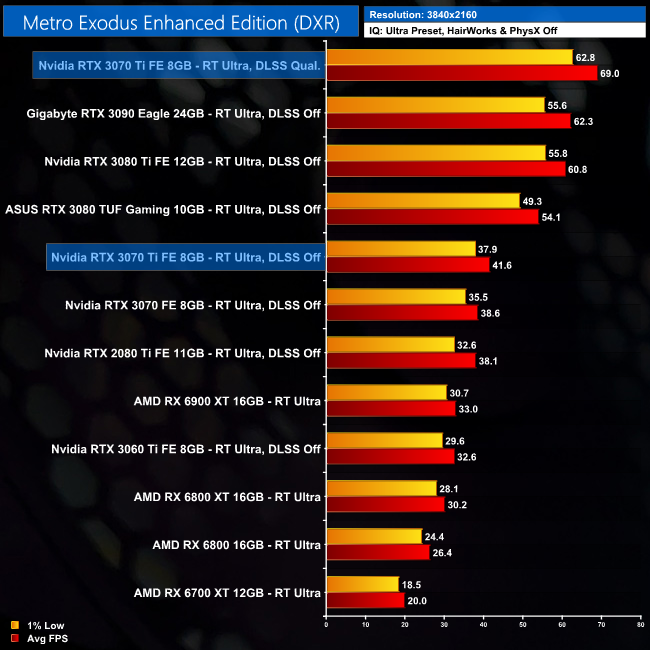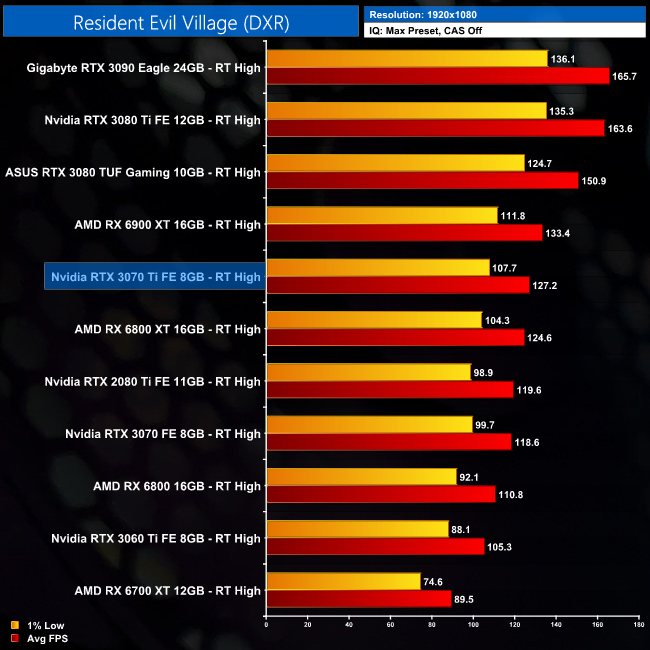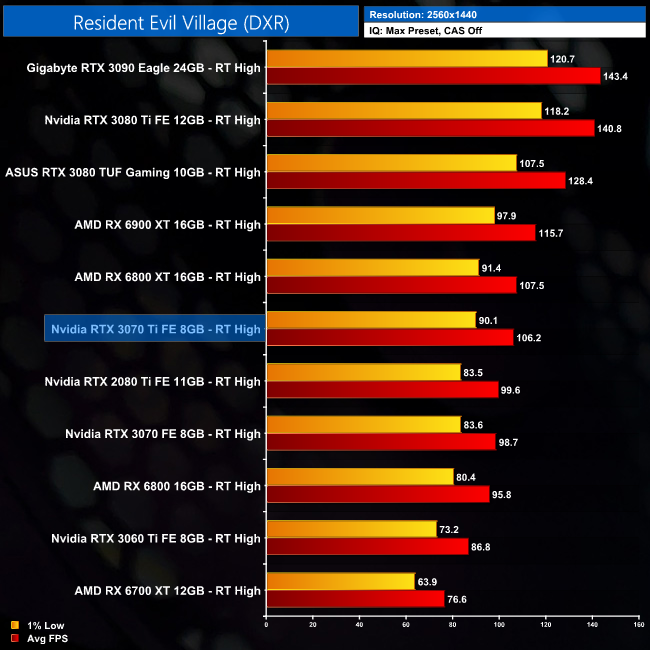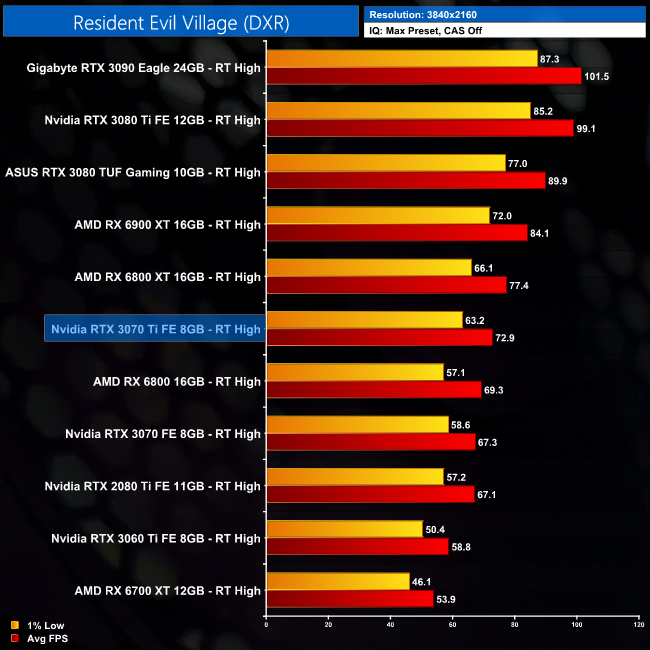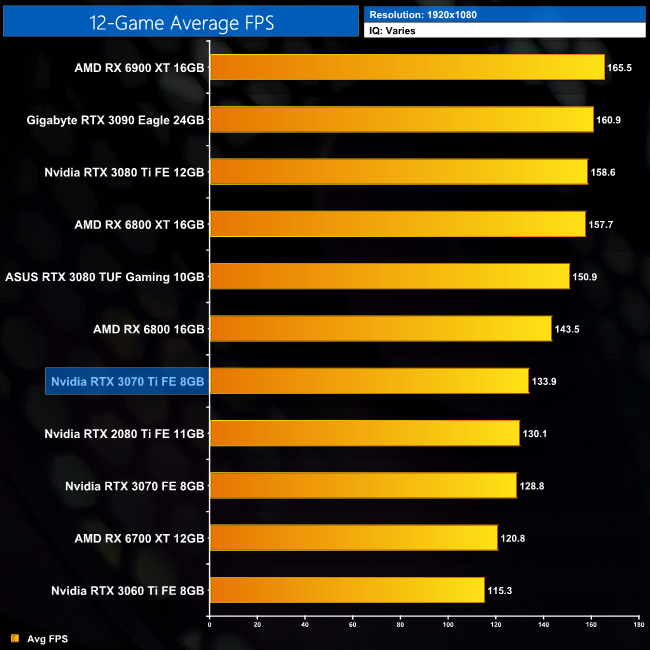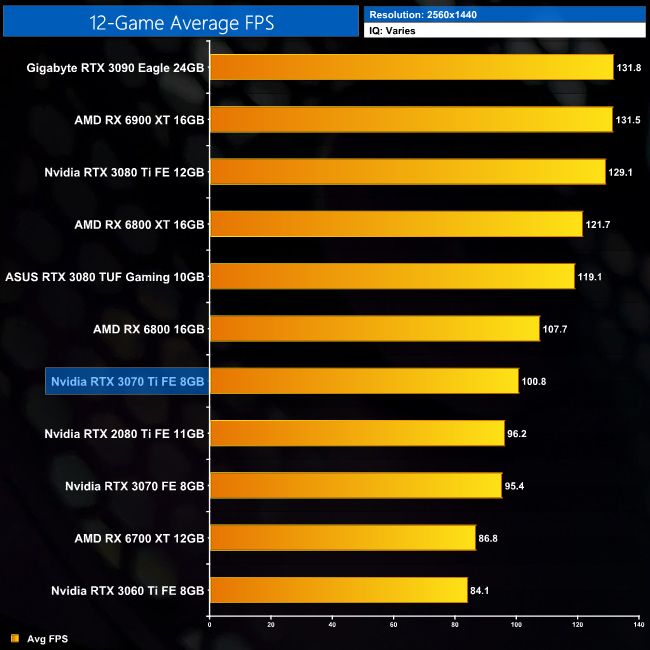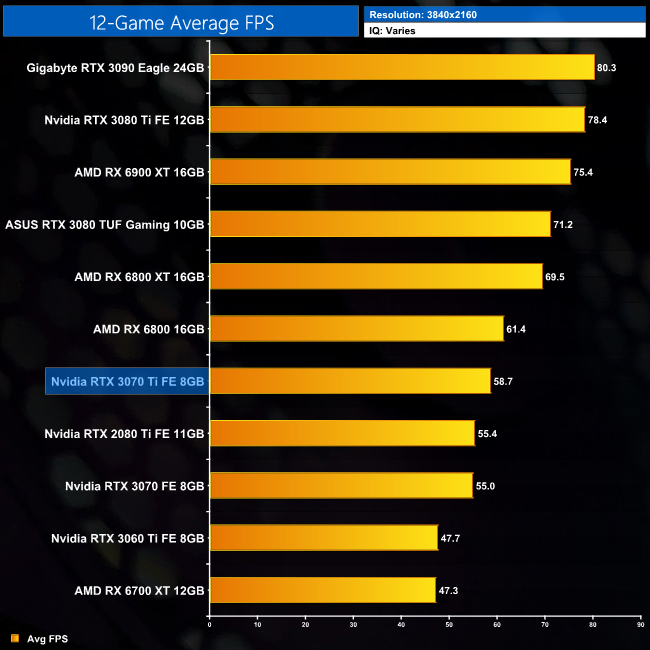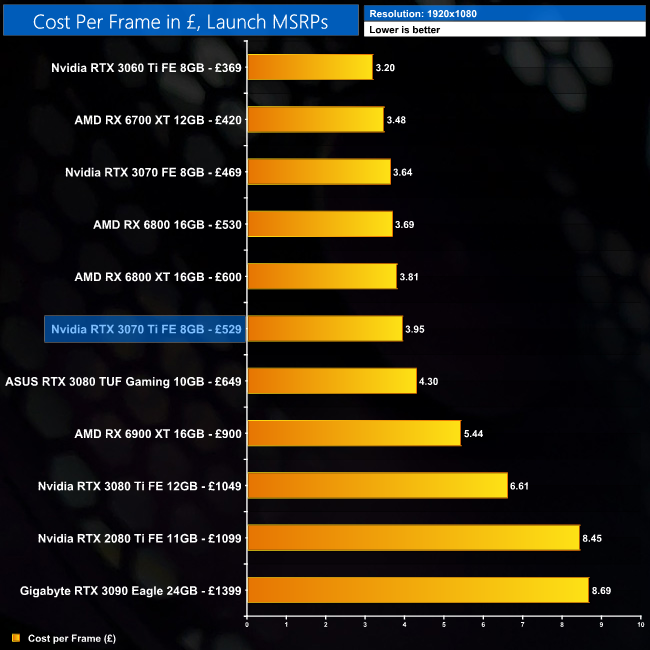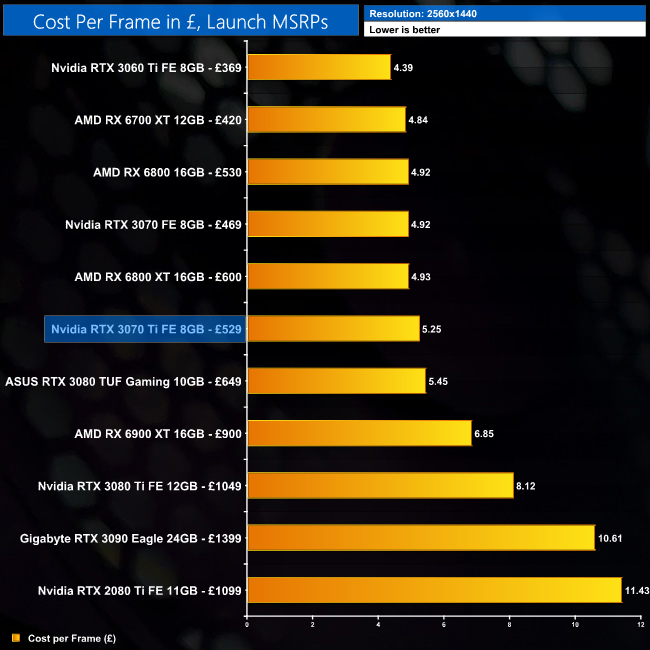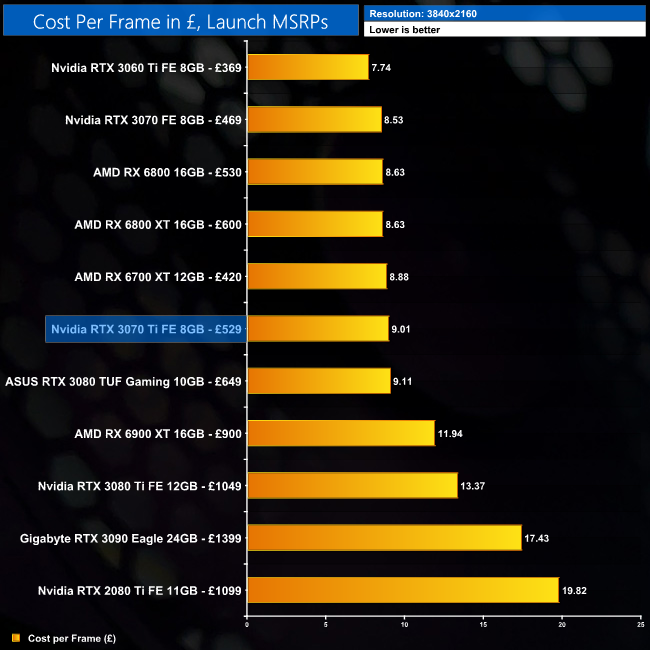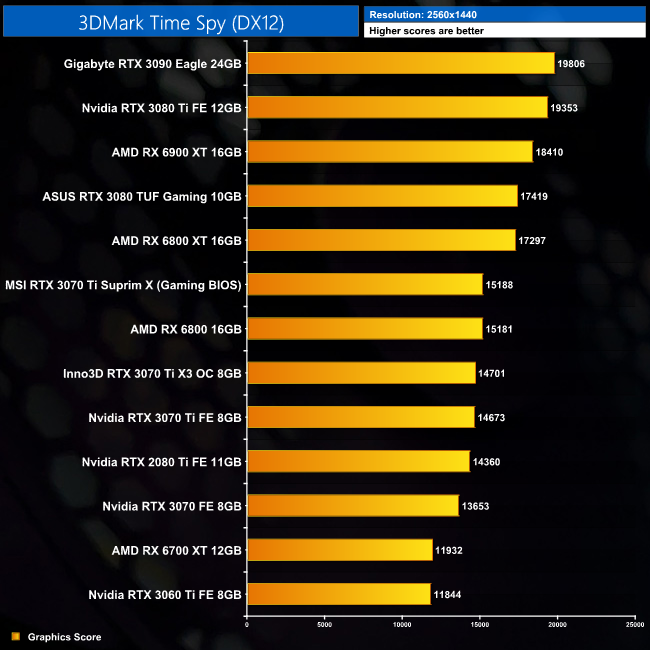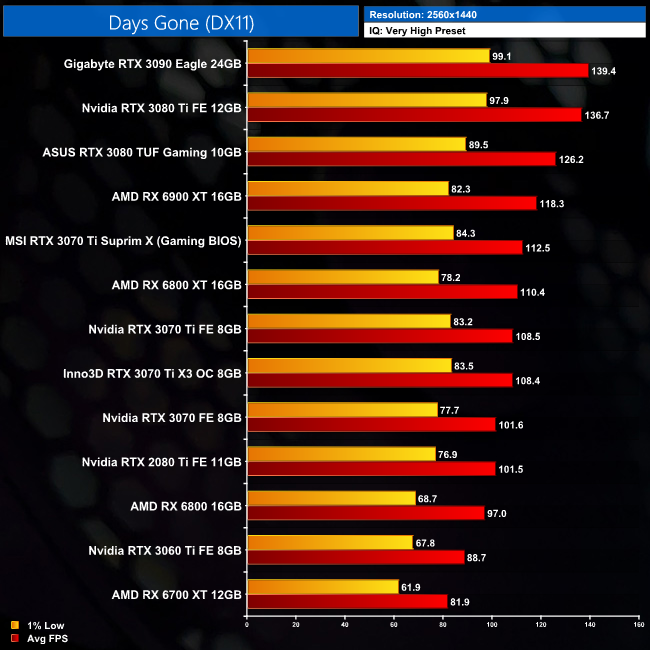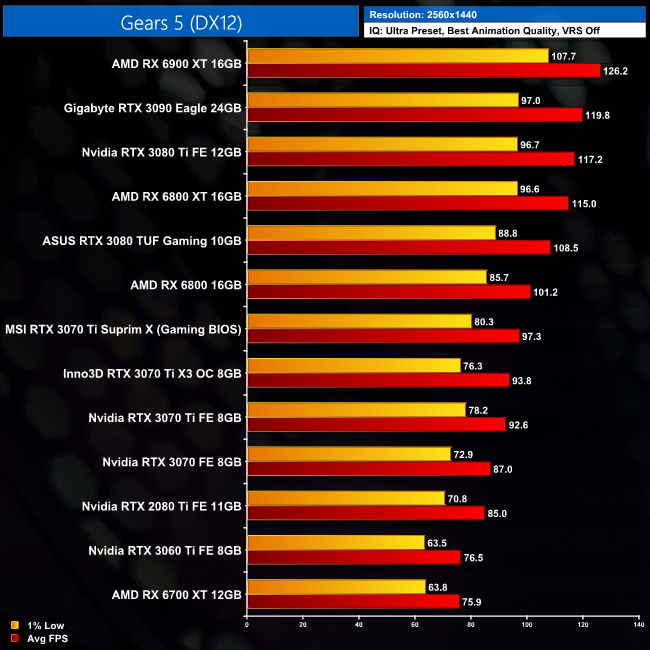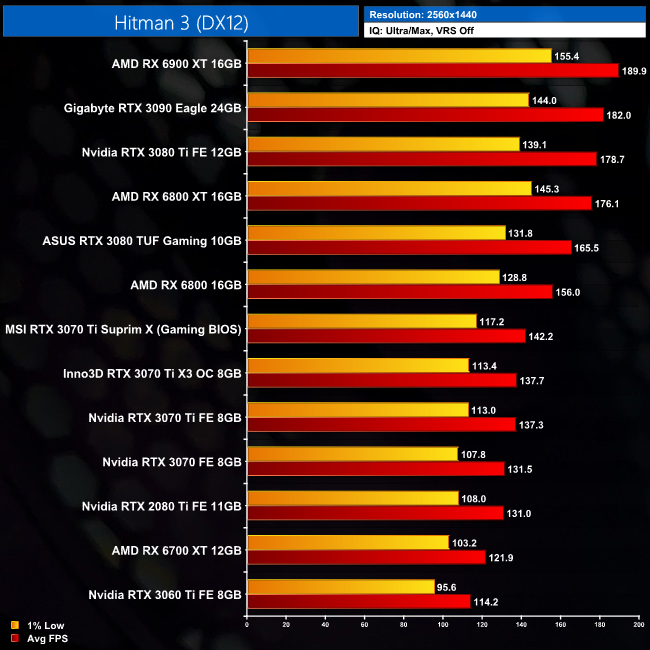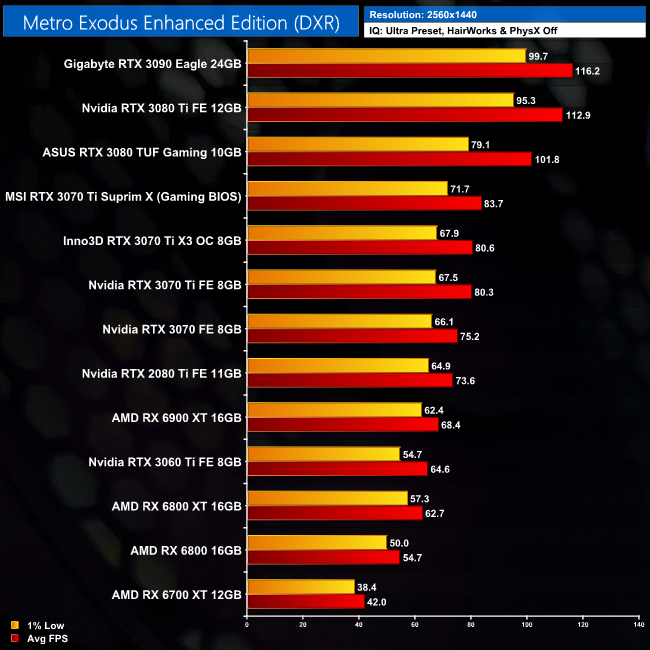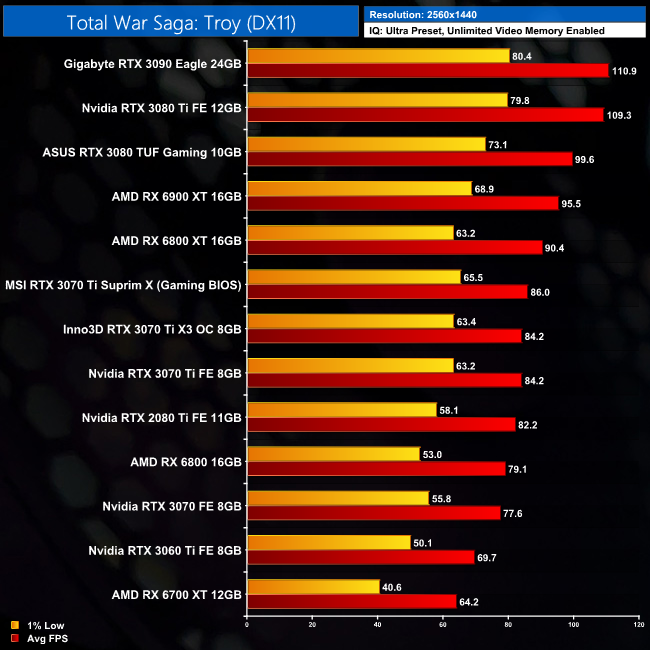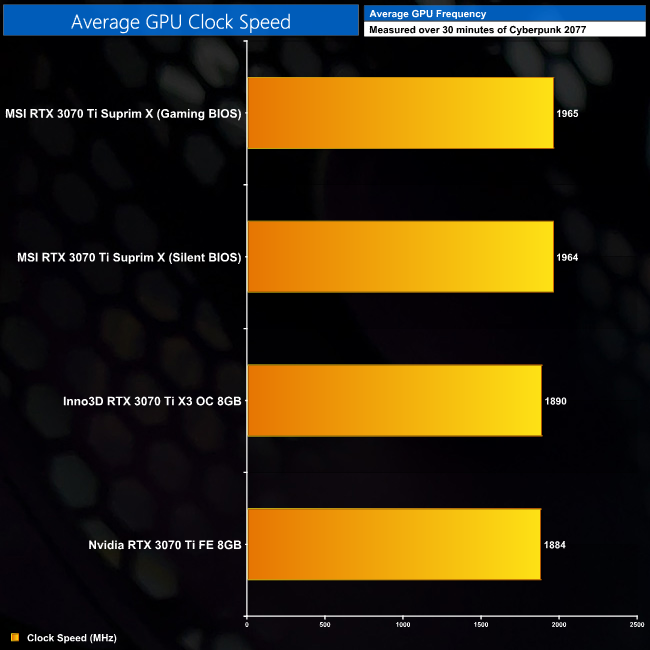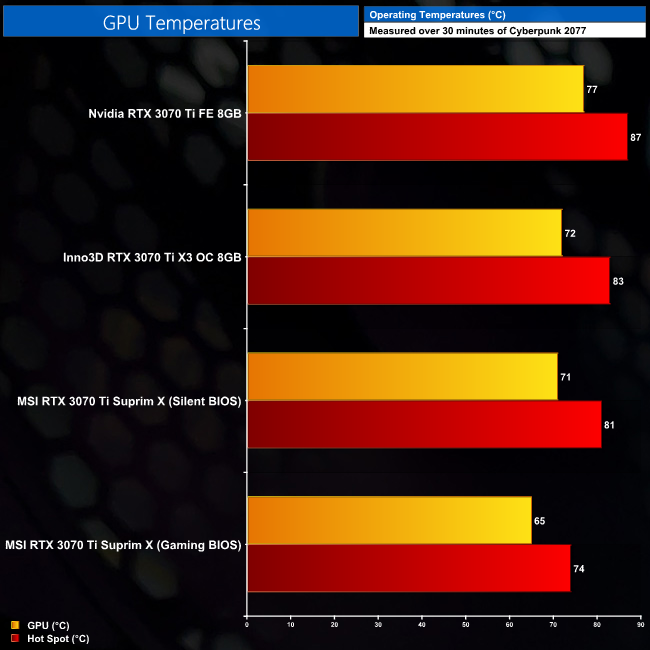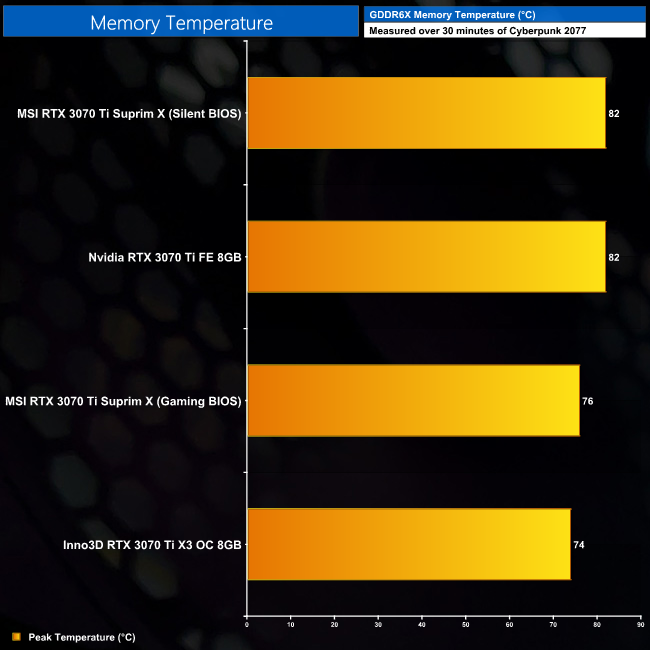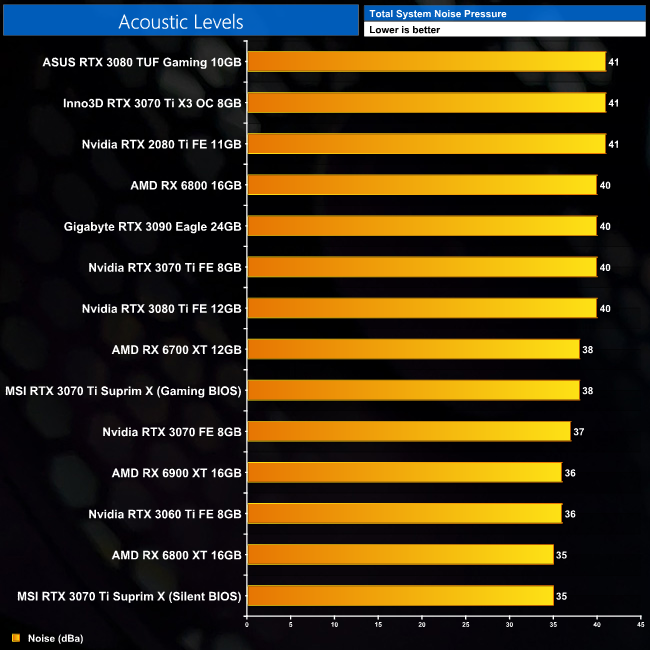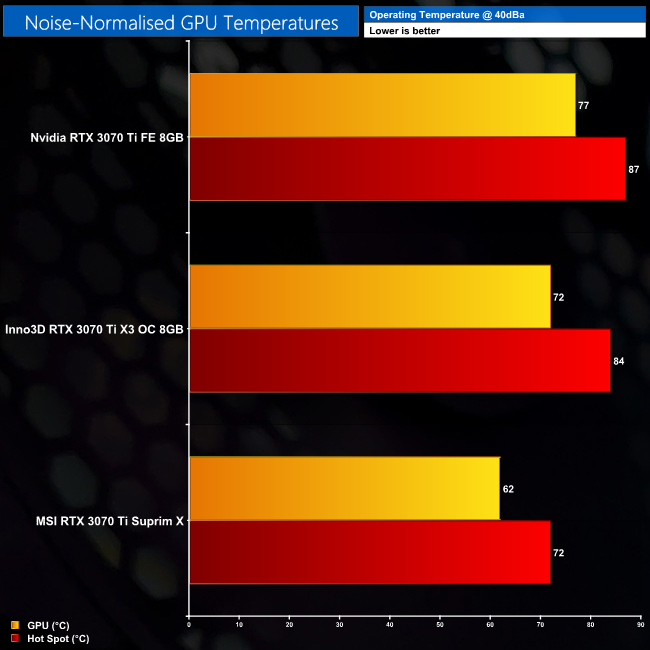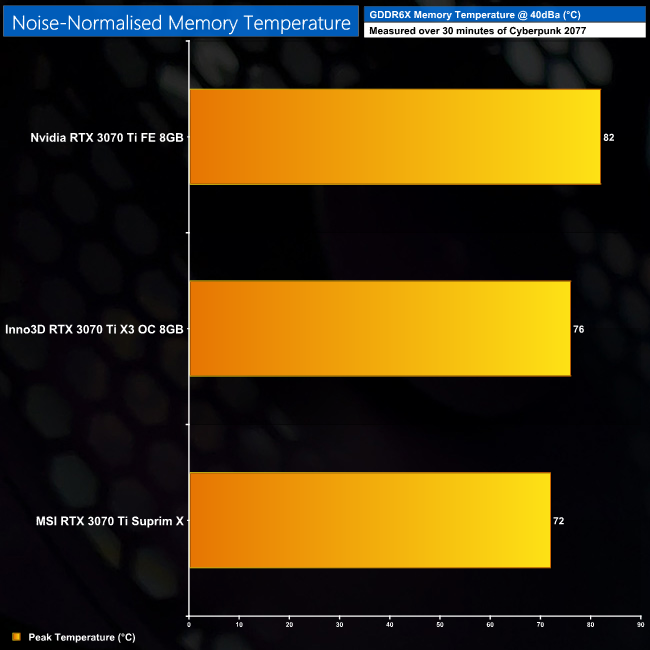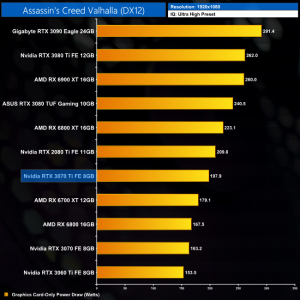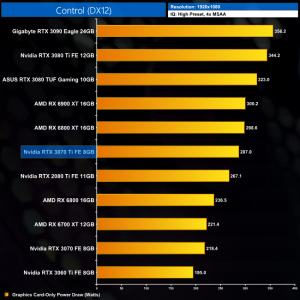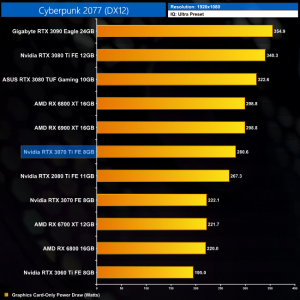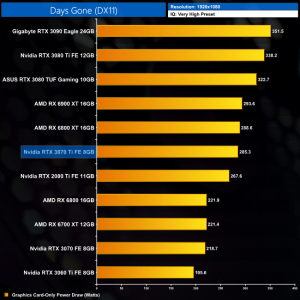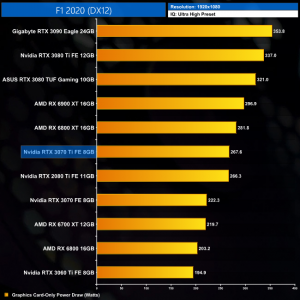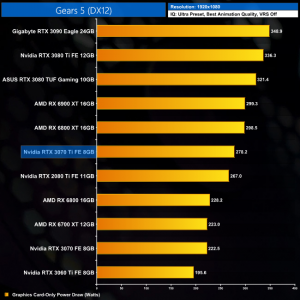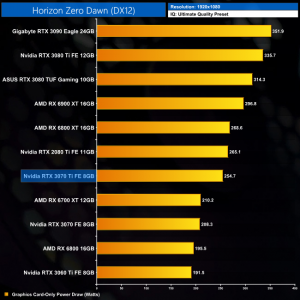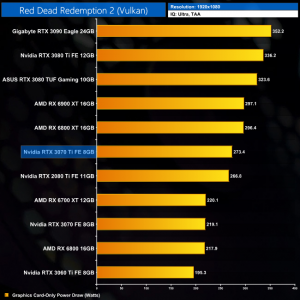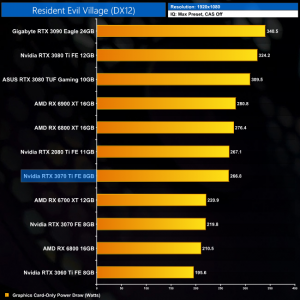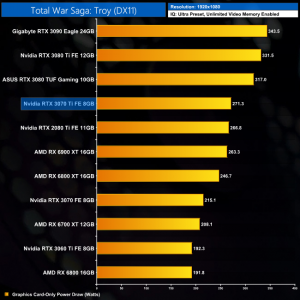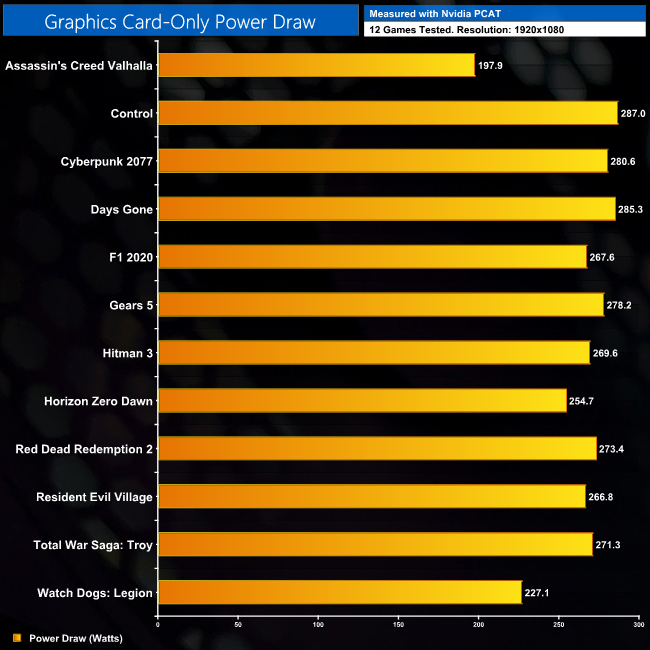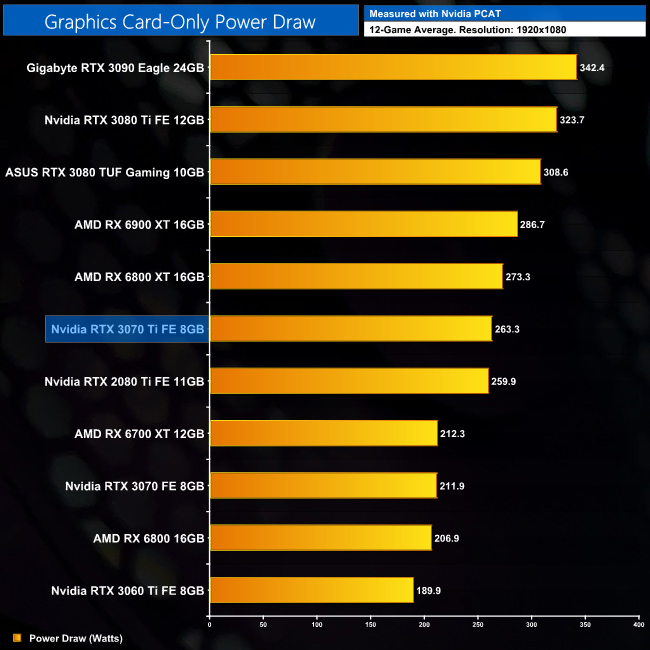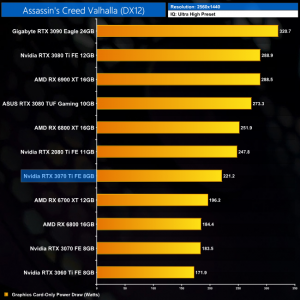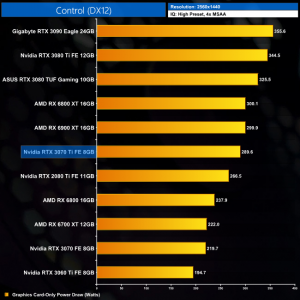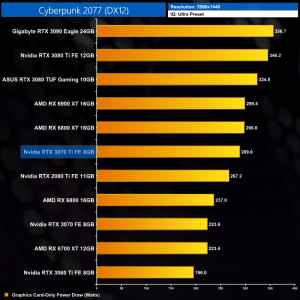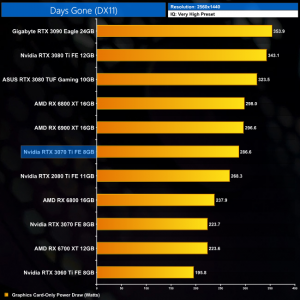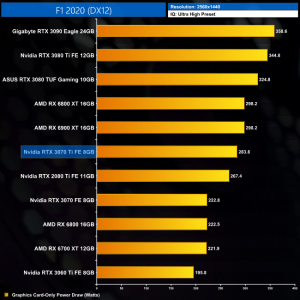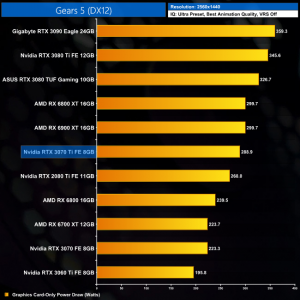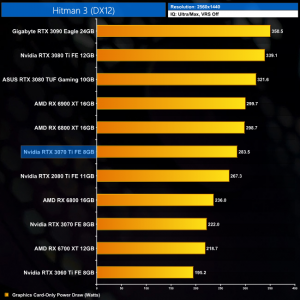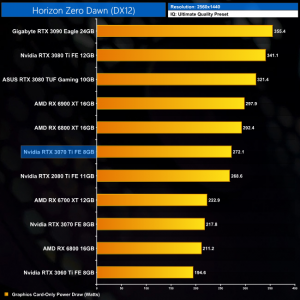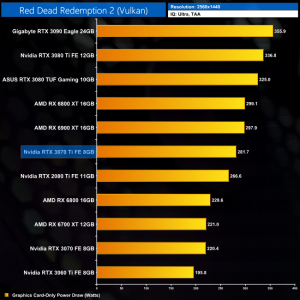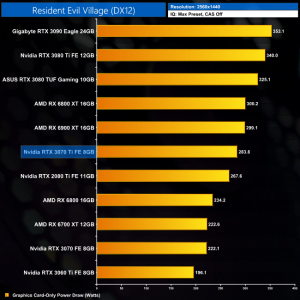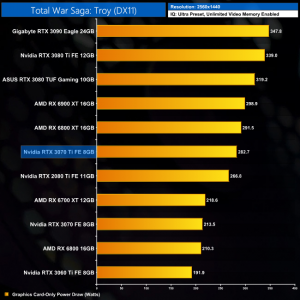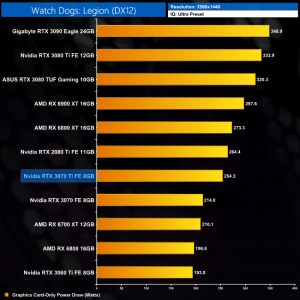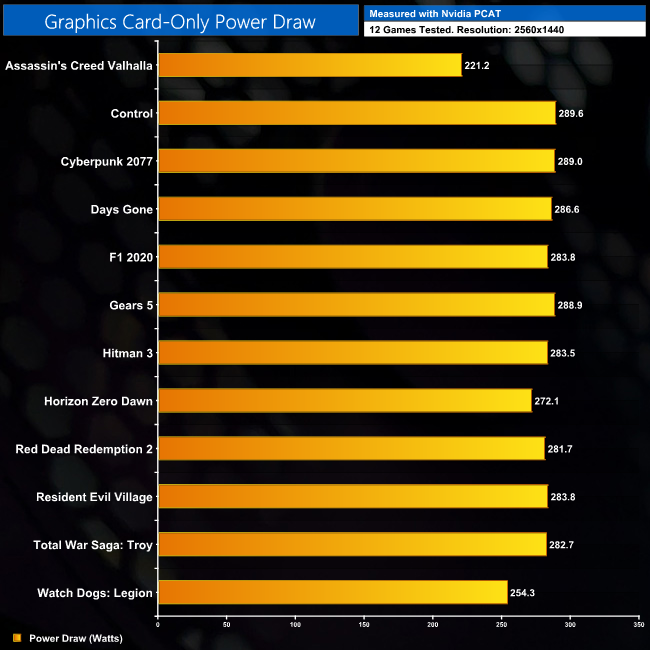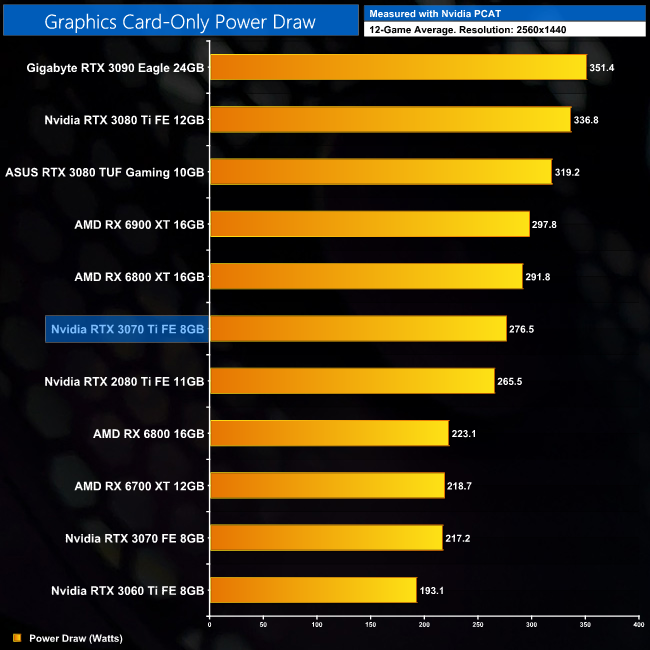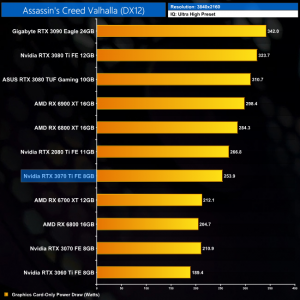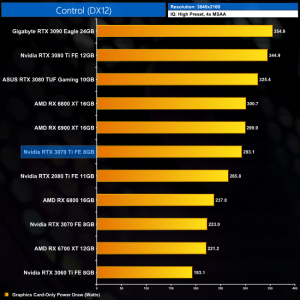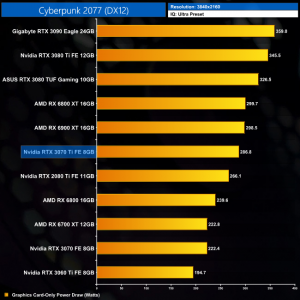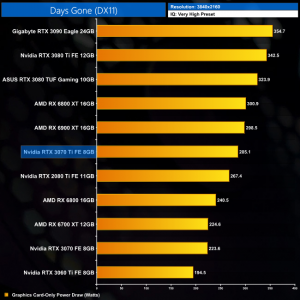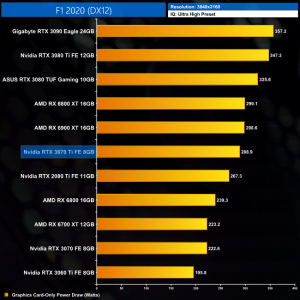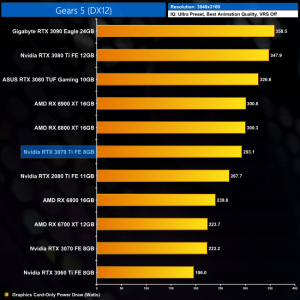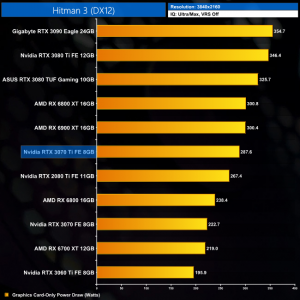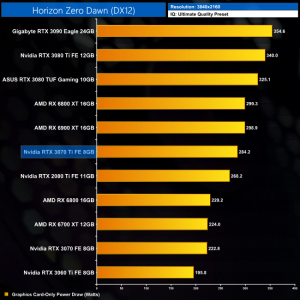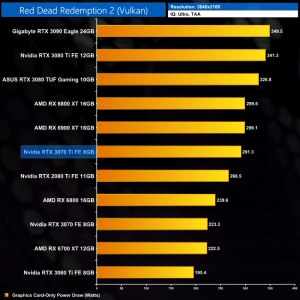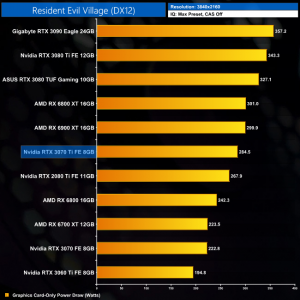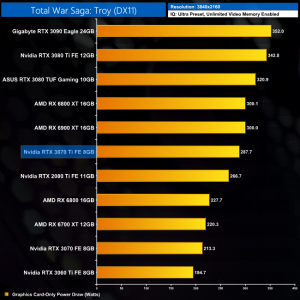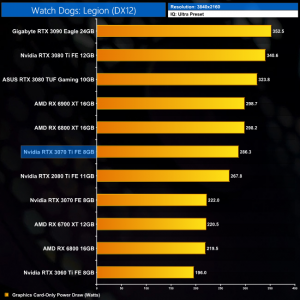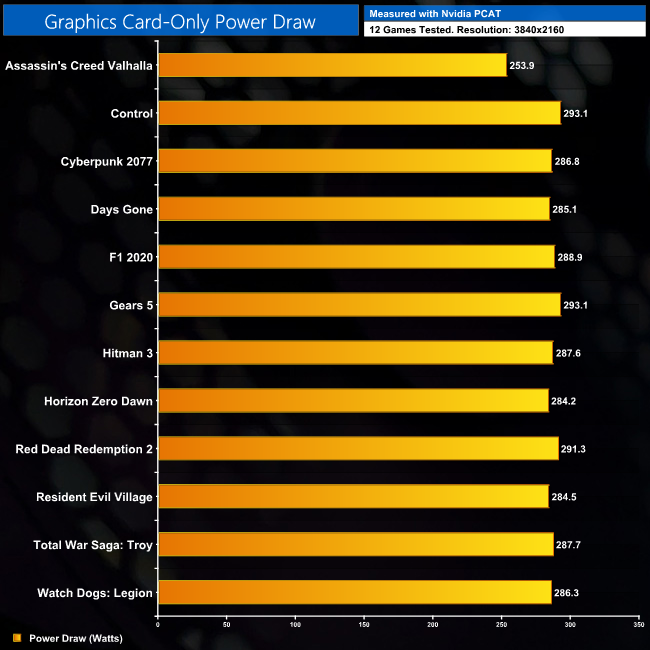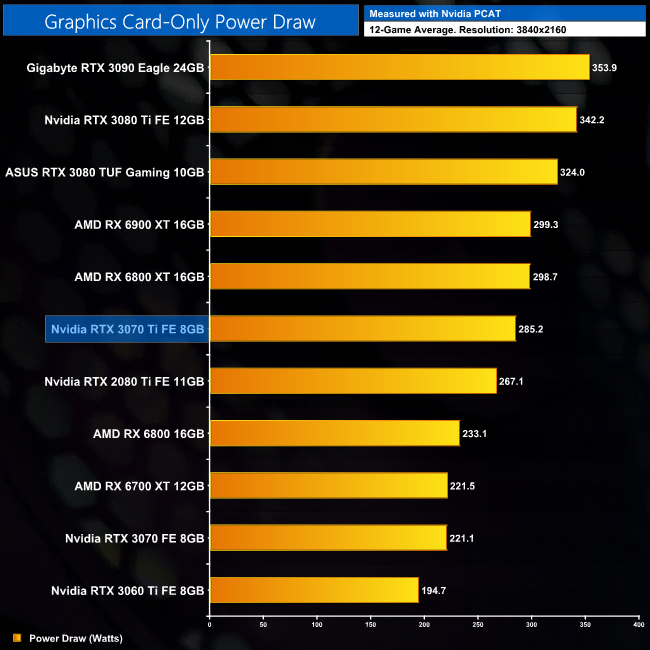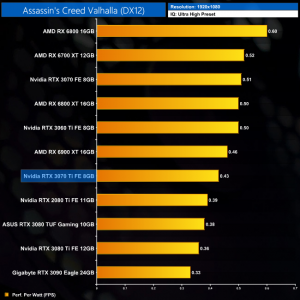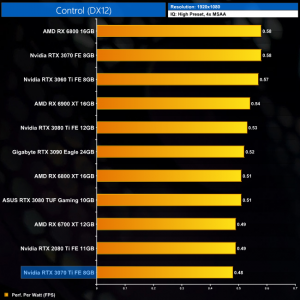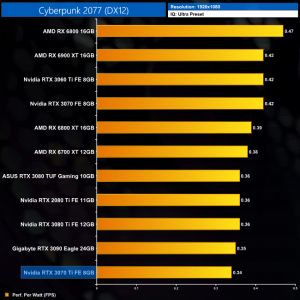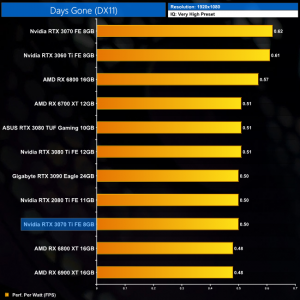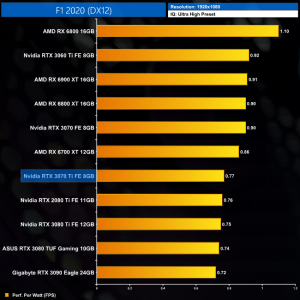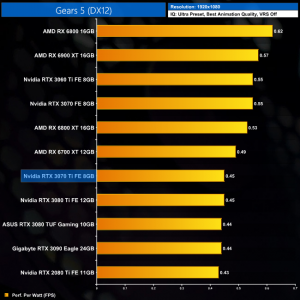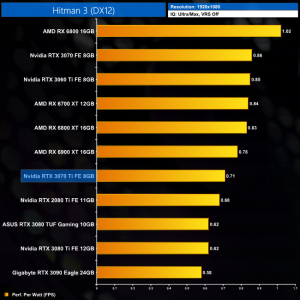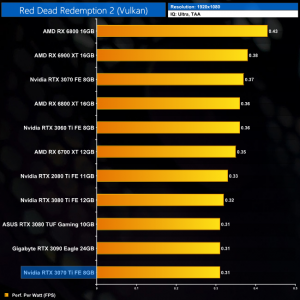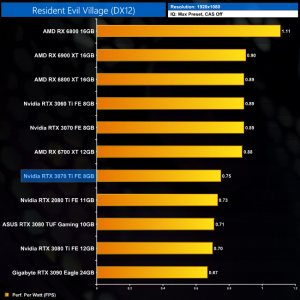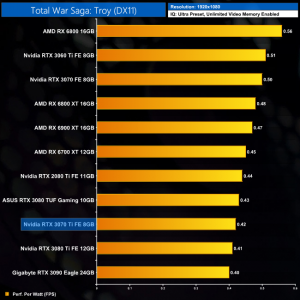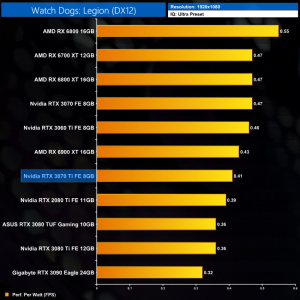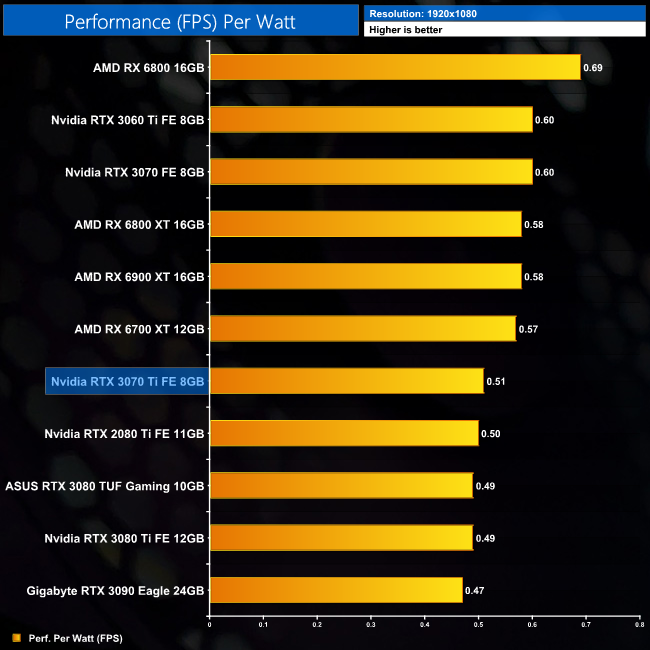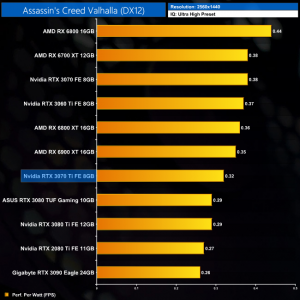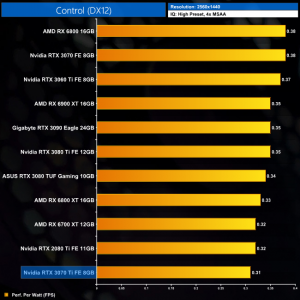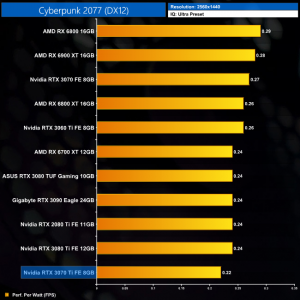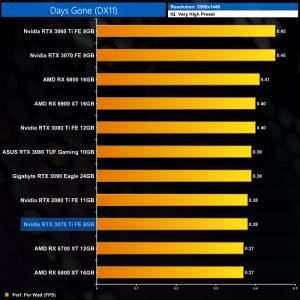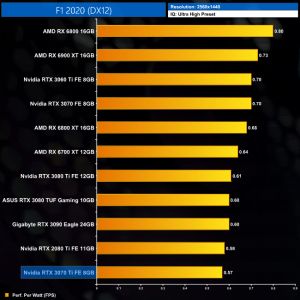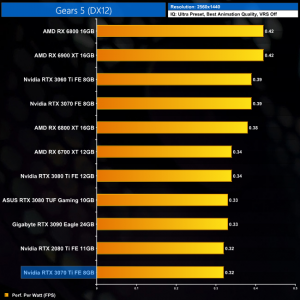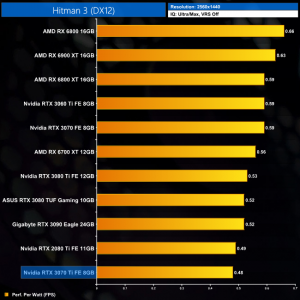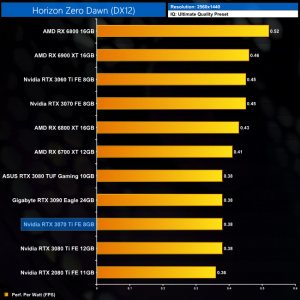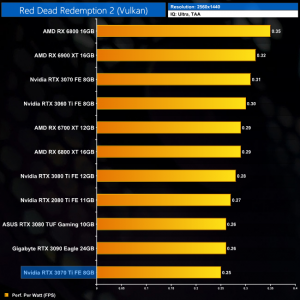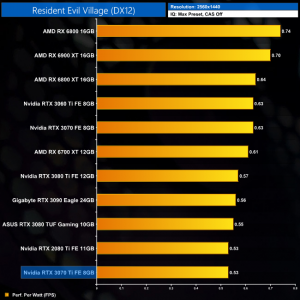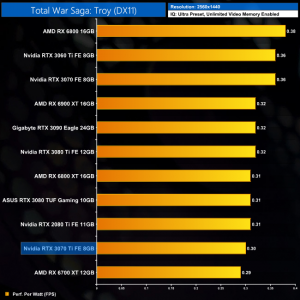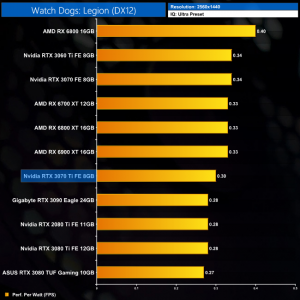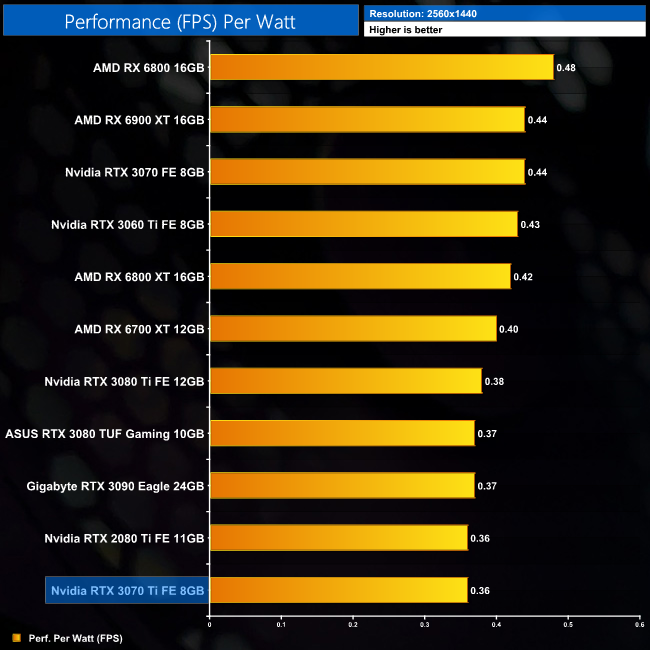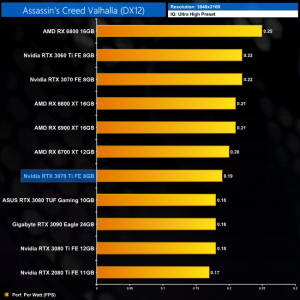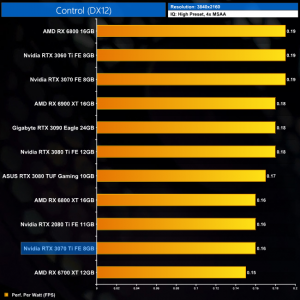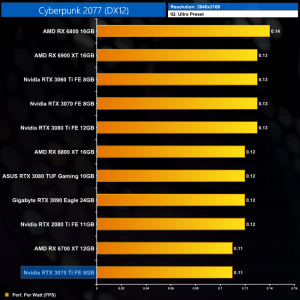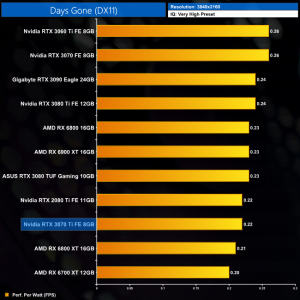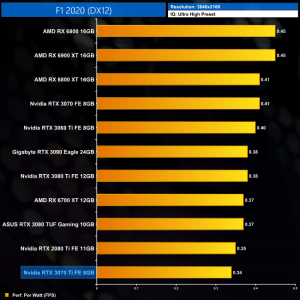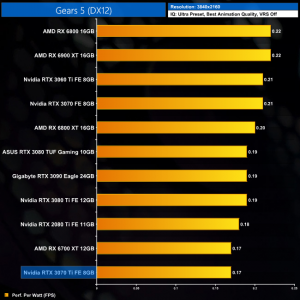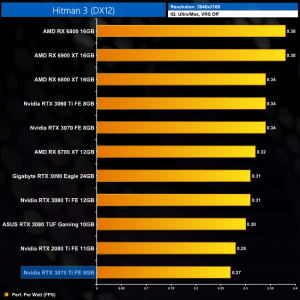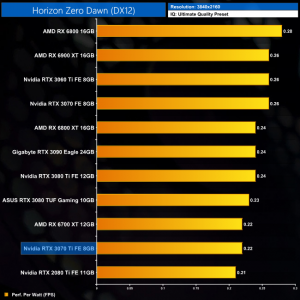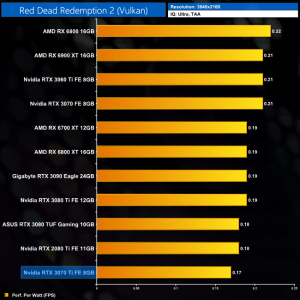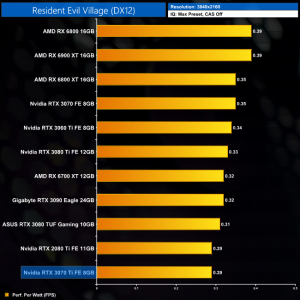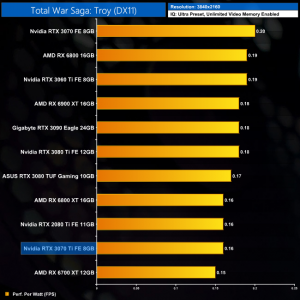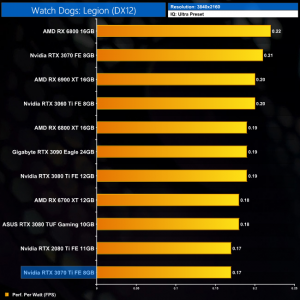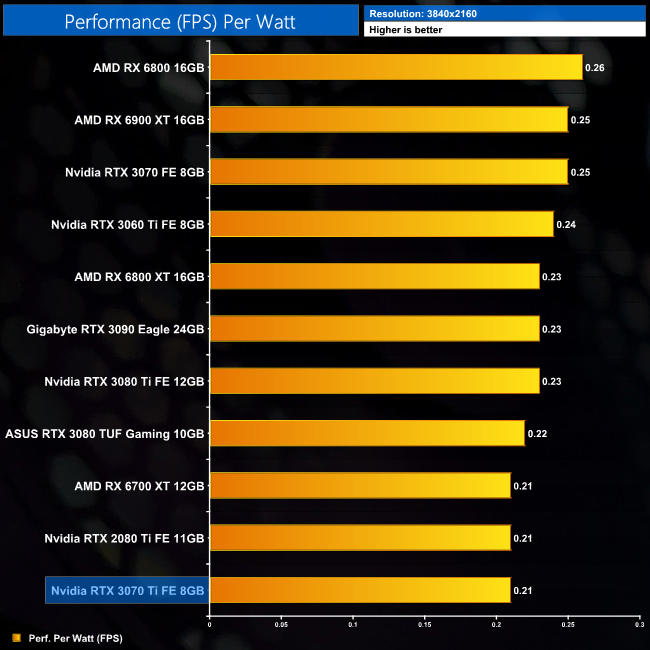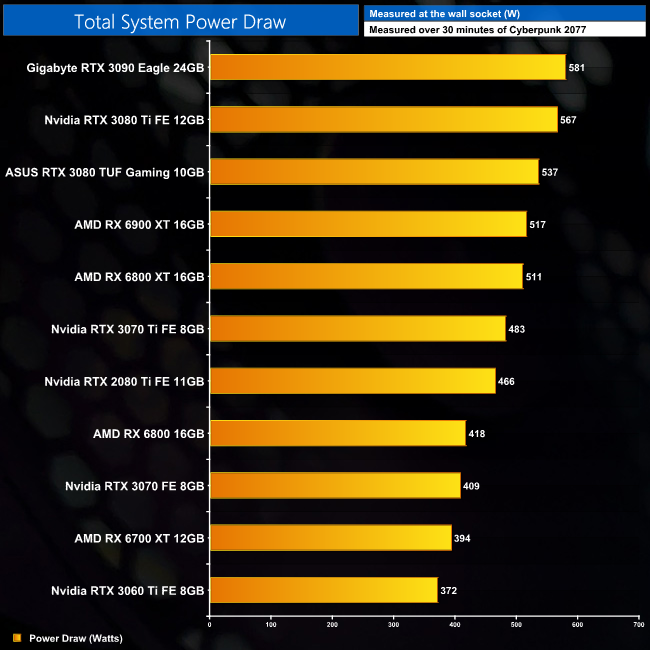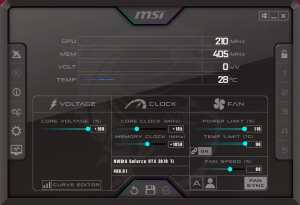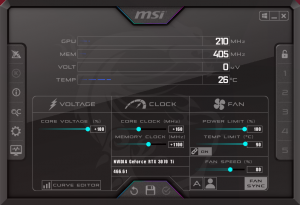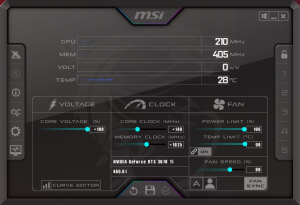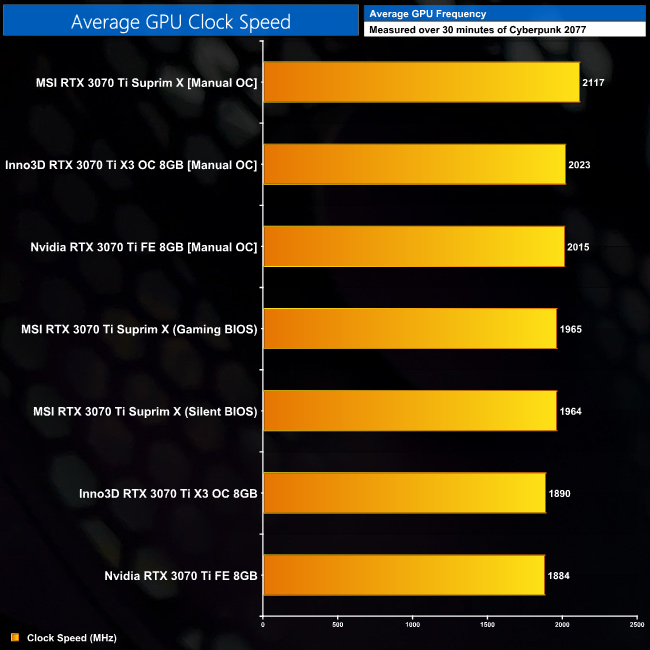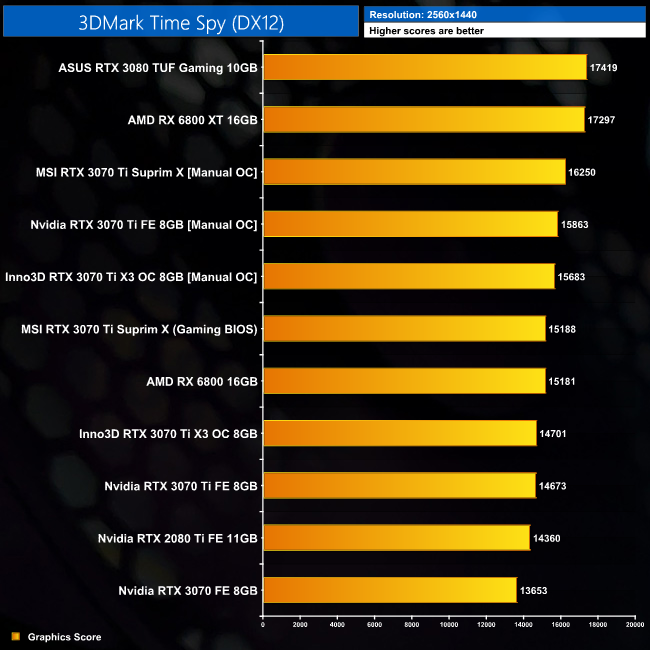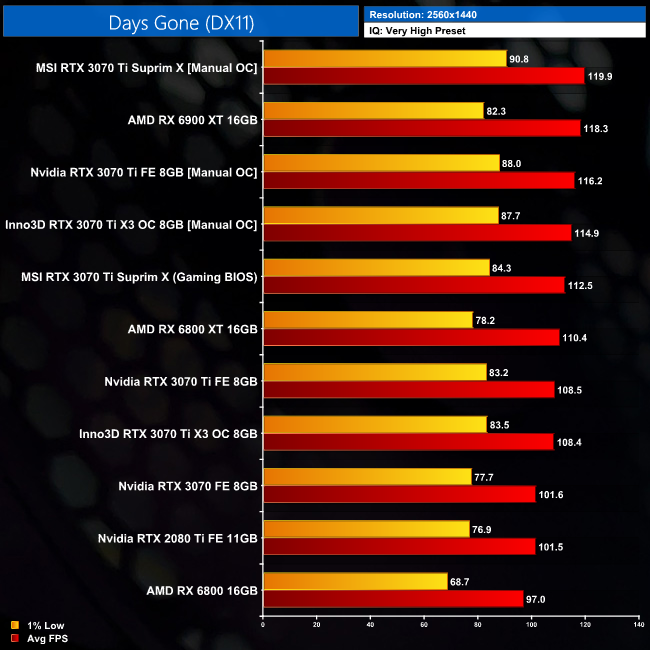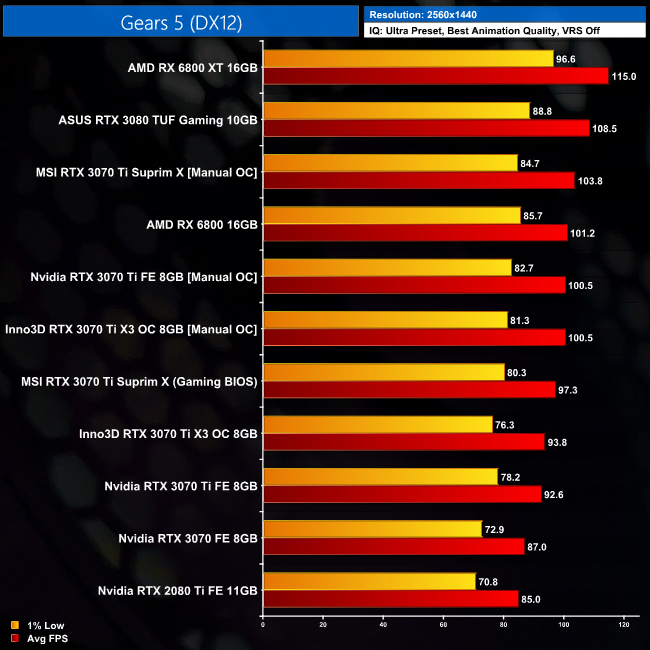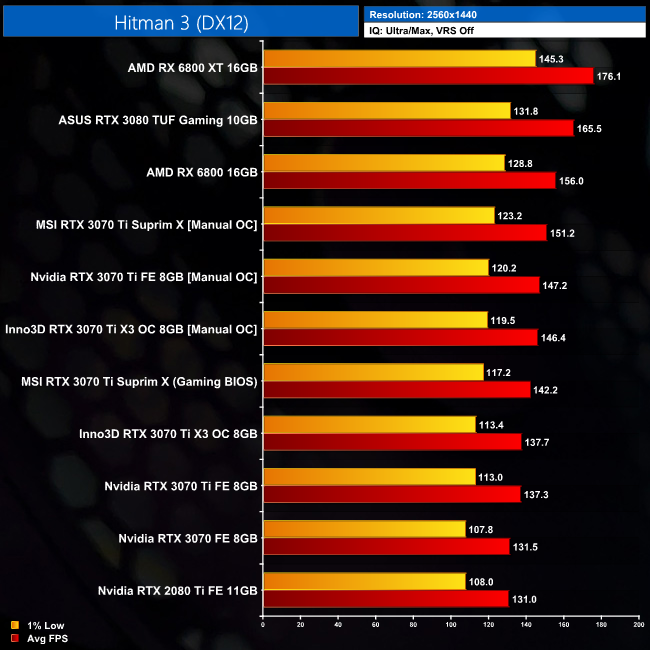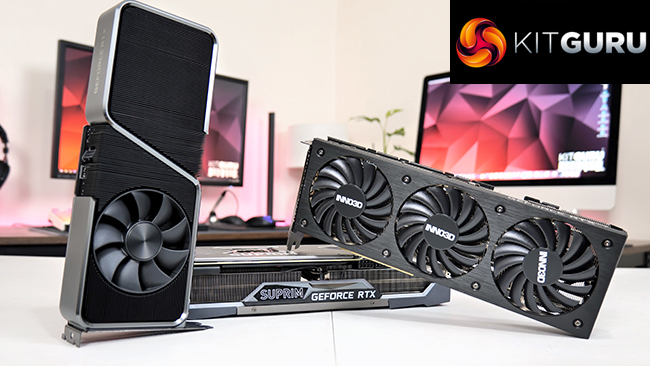Hot on the heels of our RTX 3080 Ti review, today we are back with a look at Nvidia's RTX 3070 Ti. While the core-count has only increased slightly from the RTX 3070, the RTX 3070 Ti is able to deliver a 36% boost to memory bandwidth thanks to its use of GDDR6X memory, instead of the slower GDDR6 modules found on the original model. We put this new GPU through its paces to see what sort of performance it can offer.
As always for a new Nvidia launch, here we will be assessing the RTX 3070 Ti Founders Edition, which actually uses a new cooler design we have not seen before on either the RTX 3070 or RTX 3080 Founders Edition models. As with our RTX 3080 Ti review however, we will also be comparing the Founders Edition against a couple of Nvidia's AIB partner cards.
The first of these is Inno3D's RTX 3070 Ti X3 OC, a dual-slot model with a triple-fan cooler. We also test MSI's beefy RTX 3070 Ti Suprim X, offering a gargantuan cooler, increased power limit as well as dual-BIOS functionality.
| RTX 3090 | RTX 3080 Ti | RTX 3080 | RTX 3070 Ti | RTX 3070 | |
| SMs | 82 | 80 | 68 | 48 | 46 |
| CUDA Cores | 10496 | 10240 | 8704 | 6144 | 5888 |
| Tensor Cores | 328 | 320 | 272 | 192 | 184 |
| RT Cores | 82 | 80 | 68 | 48 | 46 |
| Texture Units | 328 | 320 | 272 | 192 | 184 |
| ROPs | 112 | 112 | 96 | 96 | 96 |
| GPU Boost Clock | 1695 MHz | 1665 MHz | 1710 MHz | 1770 MHz | 1725 MHz |
| Memory Data Rate | 19.5 Gbps | 19 Gbps | 19 Gbps | 19 Gbps | 14 Gbps |
| Total Video Memory | 24GB GDDR6X | 12GB GDDR6X | 10GB GDDR6X | 8GB GDDR6X | 8GB GDDR6 |
| Memory Interface | 384-bit | 384-bit | 320-bit | 256-bit | 256-bit |
| Memory Bandwidth | 936 GB/Sec | 912 GB/Sec | 760 GB/Sec | 608 GB/Sec | 448 GB/Sec |
| TGP | 350W | 350W | 320W | 290W | 220W |
The RTX 3070 Ti uses Nvidia’s GA104 GPU, but unlike the RTX 3070, it is a fully populated die. That means the RTX 3070 Ti incorporates 48 Streaming Multiprocessors (SMs), and thanks to Ampere’s new SM structure with its two FP32 datapaths, each SM houses 128 CUDA cores, giving a total of 6144. This is only 256 more cores compared to the RTX 3070, an increase of 4%
Ampere also places one RT core and four Tensor cores in each SM, giving a total of 48 RT cores and 192 Tensor cores. This is accompanied by 192 texture units and 96 ROPs which are now housed directly within each graphics processing cluster (GPC), with 16 ROPs per GPC, and 6 GPCs in total for RTX 3070 Ti.
Clock speed is another area where Nvidia has tweaked things compared to the vanilla RTX 3070. The RTX 3070 Ti Founders Edition has a reference clock of 1770MHz, an increase of 45MHz against the RTX 3070, though both of the partner cards we test come factory overclocked. We test real-world clock speed behaviour later in this review.
For the memory, this is where we see the biggest upgrade versus the RTX 3070. While we still find the same 256-bit memory interface, in place of the slower GDDR6 modules of the RTX 3070, Nvidia has opted for GDDR6X memory clocked at 19Gbps. This offers total memory bandwidth at 608 GB/s, a 36% increase over the RTX 3070.
Lastly, for total graphics power, Nvidia rates the RTX 3070 Ti for 290W, which is a sizable increase over the RTX 3070's 220W TGP, with most of that likely going towards the GDDR6X memory. We are using our new GPU power testing methodology in this review, so read on for our most detailed power testing yet.
The RTX 3070 Ti Founders Edition ships in the same box as the RTX 3080 Ti, with a very minimalistic styling. Inside we find a quick start guide and a support guide, as well as the 2x 8-pin to 12-pin power adapter.
As for the card itself, while it is clearly an RTX 30-series card, this is actually a new cooler design – it looks something like the RTX 3070 and RTX 3080 Founders Editions models had a baby. It inherits the flow through fan design from the RTX 3080, with one fan pushing air from the underside of the card, and the other pulling air through from the top.
The greyish/silver frame of the card however, is the same as the RTX 3070 – the RTX 3080 uses an x-shape pattern which is not found here. Internally as well, the cooler does not use a vapour chamber, as is the case for the RTX 3080, but instead relies on a traditional copper baseplate with four heatpipes, just like the RTX 3070.
In terms of sizing too, the RTX 3070 Ti slots right in between the RTX 3070 and RTX 3080 Founders Editions. The RTX 3070 measures 242mm long, the RTX 3070 Ti is 267mm and the RTX 3080 is 285mm.
As for the backplate, it's most similar to the RTX 3080 as obviously there is a fan on the right hand side. Where the RTX 3080 leaves the aluminium finstack exposed around that rear fan however, the back of the RTX 3070 Ti is completely covered except for the fan itself.
We can also note Nvidia's 12-pin power connector, while display outputs are as expected, with 3x DisplayPort 1.4a, and 1x HDMI 2.1.
Looking now at the Inno3D RTX 3070 Ti X3 OC, this ships in an eye-catching box, though no image of the card is visible on the front. Inside, the only included accessories are a couple pieces of documentation.
Taking a look at the card itself, it's a much more subdued design compared to the RTX 3080 Ti iChill X4 that we reviewed last week. Gone is the angled and aggressive shroud design, and instead we have what is essentially a plain black rectangle. The shroud is clearly black, but it is made of brushed metal so it feels sturdy in the hand.
We can also note the triple-fan setup, with three 90mm fans, each sporting 15 closely-packed fan blades.
In terms of dimensions, it's good to see Inno3D have kept the X3 OC to a standard dual-slot thickness – triple-slot cards are basically the norm in 2021, but this is certainly more svelte. It also measures 300mm long and 112mm tall.
The backplate is also plain black, and it is made of metal. We can see a cut-out around the back of the GPU die, while there are also a few triangular cut-outs at the end of the card to allow air to pass directly through the heatsink.
Power requirements consist of 2x 8-pin connectors, while once more we find 3x DisplayPort 1.4a and 1x HDMI 2.1 display outputs.
PCB and heatsink images supplied by Inno3D.
As with the RTX 3080 Ti iChill X4, Inno3D asked us not to disassemble the card, but they did provide their own photos of the PCB and heatsink layout.
Starting with the PCB, we can note a 9-phase VRM for the GPU and a 2-phase VRM for the memory. The GPU VRM uses Alpha & Omega AOZ5311NQI MOSFETs, while the memory uses UBIQ's M3816N MOSFETs. We can also note the UPI uP9512R controller for the VRM, and while we can't make out the controller for the memory VRM, it is likely UPI's uS5650Q.
Looking now at the cooler, Inno3D is using three finstacks connected by a total of 5 heatpipes. The GPU and memory contact with a central baseplate, while there are secondary plates to cool the VRM.
Our final AIB card is MSI's RTX 3070 Ti Suprim X. This ships in a white box, with a large image of the card itself visible on the front, alongside the Suprim X branding.
A wealth of accessories are included. Most of these are small quick start guides and other assorted documents, but MSI also included a mousepad and a GPU support holder to prevent any unwanted GPU sag.
Looking at the card itself, you can certainly see some familiar design elements that have carried over from the Gaming X Trio line. The shroud is now made of a combination of metal and plastic however, with the metal plates have a subtle gold hue to them.
MSI has also equipped the Suprim X with three 100mm fans, with a total of 10 swept fan blades per fan.
There's no getting around the fact that this is a big card, too, as it measures in at 335 x 140 x 61 mm. That means it's a proper triple-slot card, while it also weighs in just shy of 1.8KG.
Looking at the backplate, this is a full-length metal design. It also sports a lovely two-tone finish as a result of the metal being brushed in different directions. It's certainly very easy on the eye, while we can also note several small cut-outs towards the end of the card.
MSI includes dual-BIOS on the Suprim X, too, with the switch positioned towards the I/O bracket. There is a choice of the Gaming or Silent BIOS, though both share the same same power limit and clock speed, the only difference is the default fan speed.
Despite increasing power limit to 310W (20W above reference spec), the Suprim X remains with 2x 8-pin power connectors, while we can also note 3x DisplayPort 1.4a and 1x HDMI 2.1 connectors.
Looking now at the PCB, it would appear MSI is using a beefed-up version of the PCB we saw with the RTX 3070 Gaming X Trio last year. That means we have an 11-phase VRM for the the GPU and a 2-phase VRM for the memory. The former uses Alpha & Omega AOZ5332QI MOSFETs, while the latter uses Niko Semi PK616BA and PK698SA high and low-side MOSFETs.
The memory VRM is controlled by OnSemi's NCP81610, while the memory is controlled by the UPI uS5650Q.
The heatsink is comprised of two hefty finstacks, which are connected by 7x 6mm heatpipes. There is an eighth heatpipes visible, but this is reserved exclusively for memory cooling. The GPU contacts with a central baseplate, while the memory sits half on that same baseplate, and half on the aforementioned heatpipe. Secondary plates are used to cool the VRM.
Lastly, we can see MSI's backplate makes contact with the back of the PCB, with thermal pads behind the memory and GPU VRM areas.
Driver Notes
- All Nvidia GPUs (except RTX 3080 Ti) were benchmarked with the 466.47 driver.
- RTX 3080 Ti was benchmarked with the 466.54 driver supplied to press.
- RTX 3070 Ti was benchmarked with the 466.61 driver supplied to press.
- All AMD GPUs were benchmarked with the Adrenalin 21.5.2 driver.
Test System
We test using the a custom built system from PCSpecialist, based on Intel's Comet Lake-S platform. You can read more about it over HERE, and configure your own system from PCSpecialist HERE.
| CPU |
Intel Core i9-10900K
Overclocked to 5.1GHz on all cores |
| Motherboard |
ASUS ROG Maximus XII Hero Wi-Fi
|
| Memory |
Corsair Vengeance DDR4 3600MHz (4 X 8GB)
CL 18-22-22-42
|
| Graphics Card |
Varies
|
| System Drive |
500GB Samsung 970 Evo Plus M.2
|
| Games Drive | 2TB Samsung 860 QVO 2.5″ SSD |
| Chassis | Fractal Meshify S2 Blackout Tempered Glass |
| CPU Cooler |
Corsair H115i RGB Platinum Hydro Series
|
| Power Supply |
Corsair 1200W HX Series Modular 80 Plus Platinum
|
| Operating System |
Windows 10 2004
|
Comparison Graphics Cards List
- Gigabyte RTX 3090 Eagle 24GB
- ASUS RTX 3080 TUF Gaming 10GB
- Nvidia RTX 3080 Ti FE 12GB
- Nvidia RTX 3070 FE 8GB
- Nvidia RTX 3060 Ti FE 8GB
- Nvidia RTX 2080 Ti FE 11GB
- AMD RX 6900 XT 16GB
- AMD RX 6800 XT 16GB
- AMD RX 6800 16GB
- AMD RX 6700 XT 12GB
Software and Games List
- 3DMark Fire Strike & Fire Strike Ultra (DX11 Synthetic)
- 3DMark Time Spy (DX12 Synthetic)
- 3DMark Raytracing Feature Test (DXR Synthetic)
- Assassin's Creed Valhalla (DX12)
- Control (DX12)
- Cyberpunk 2077 (DX12)
- Days Gone (DX11)
- F1 2020 (DX12)
- Gears 5 (DX12)
- Hitman 3 (DX12)
- Horizon Zero Dawn (DX12)
- Metro Exodus Enhanced Edition (DXR)
- Red Dead Redemption 2 (Vulkan)
- Resident Evil Village (DX12)
- Total War Saga: Troy (DX11)
- Watch Dogs: Legion (DX12)
We run each benchmark/game three times, and present mean averages in our graphs. We use FrameView to measure average frame rates as well as 1% low values across our three runs.
Fire Strike is a showcase DirectX 11 benchmark for modern gaming PCs. Its ambitious real-time graphics are rendered with detail and complexity far beyond other DirectX 11 benchmarks and games. Fire Strike includes two graphics tests, a physics test and a combined test that stresses the CPU and GPU. (UL).
3DMark Time Spy is a DirectX 12 benchmark test for Windows 10 gaming PCs. Time Spy is one of the first DirectX 12 apps to be built the right way from the ground up to fully realize the performance gains that the new API offers. With its pure DirectX 12 engine, which supports new API features like asynchronous compute, explicit multi-adapter, and multi-threading, Time Spy is the ideal test for benchmarking the latest graphics cards. (UL).
Starting with our 3DMark benchmarks, we can see the RTX 3070 Ti out-scoring the RTX 3070 by varying degrees across the three tests. In Fire Strike, for instance, the RTX 3070 Ti is 6% faster, while this increases to 8% in the DX12 Time Spy Test. Fire Strike Ultra, meanwhile, sees the 3070 Ti outperform the 3070 by a 7% margin.
Real-time ray tracing is incredibly demanding. The latest graphics cards have dedicated hardware that’s optimized for ray-tracing. The 3DMark DirectX Raytracing feature test measures the performance of this dedicated hardware. Instead of using traditional rendering techniques, the whole scene is ray-traced and drawn in one pass. The result of the test depends entirely on ray-tracing performance. (UL).
3DMarks' DXR feature-test is a tough test of a GPU's ray tracing abilities. Despite the significant increase to memory bandwidth, the RTX 3070 Ti only has an extra two RT cores compared to the RTX 3070, and is just 1% faster in this test.
Assassin's Creed Valhalla is an action role-playing video game developed by Ubisoft Montreal and published by Ubisoft. It is the twelfth major installment and the twenty-second release in the Assassin's Creed series, and a successor to the 2018's Assassin's Creed Odyssey. The game was released on November 10, 2020, for Microsoft Windows, PlayStation 4, Xbox One, Xbox Series X and Series S, and Stadia, while the PlayStation 5 version was released on November 12. (Wikipedia.)
Engine: AnvilNext 2.0. We test using the Ultra High preset, DX12 API.
Kicking off the game benchmarks with Assassin's Creed Valhalla, this isn't the best of starts for the RTX 3070 Ti. At 1440p, it averaged just shy of 72FPS, making it barely 3% faster than the vanilla RTX 3070. That puts it well behind the RX 6800, which is particularly strong in Valhalla, with a 12% margin between the two cards.
As for 4K, here the 3070 Ti has caught up to the RX 6800, though it's still 7% slower. The main thing however is we're still only looking at a 4% uplift versus the RTX 3070, so it's really not much of a difference at all in this game.
Control is an action-adventure video game developed by Remedy Entertainment and published by 505 Games. Control was released on 27 August 2019 for Microsoft Windows, PlayStation 4, and Xbox One. (Wikipedia).
Engine: Northlight Engine. We test using the High preset, with 4x MSAA, DX12 API.
Next is Remedy's Control, and the RTX 3070 Ti is stronger here. First and foremost, Nvidia GPUs do much better in this game so it's no surprise to see the RTX 3070 Ti edging ahead of the RX 6800 at 1440p and 4K. That's also because the 3070 Ti is 8% faster than the RTX 3070 at 1440p, and 9% faster at 4K, so the benefits to this new GPU are much more noticeable in this title. It's still not a stunning difference between the two xx70-series SKUs, but it's not nothing.
Cyberpunk 2077 is a 2020 action role-playing video game developed and published by CD Projekt. The story takes place in Night City, an open world set in the Cyberpunk universe. Players assume the first-person perspective of a customisable mercenary known as V, who can acquire skills in hacking and machinery with options for melee and ranged combat. Cyberpunk 2077 was released for Microsoft Windows, PlayStation 4, Stadia, and Xbox One on 10 December 2020. (Wikipedia).
Engine: REDengine 4. We test using the Ultra preset, DX12 API.
As for Cyberpunk 2077, starting at 1440p we can see the RTX 3070 Ti averaged 64FPS, and that makes it 8% faster than the RTX 3070, which is actually one of the bigger differences between those two GPUs we will see today. Despite being an Nvidia-sponsored title, the 3070 Ti is also 7% slower than the RX 6800 here.
Up at 4K the gap between the 3070 and 3070 Ti shrinks slightly, with a 7% difference between the two, although that is only 2FPS in the real world. The 3070 Ti is also 2FPS behind the RX 6800, but realistically you're going to want a more powerful GPU for 4K gaming in Cyberpunk 2077.
Days Gone is a 2019 action-adventure survival horror video game developed by Bend Studio and published by Sony Interactive Entertainment for the PlayStation 4 and Microsoft Windows. As part of Sony's efforts to bring more of its first-party content to Microsoft Windows following Horizon Zero Dawn, Days Gone released on Windows on May 18, 2021. (Wikipedia).
Engine: Unreal Engine 4. We test using the Very High preset, DX11 API.
Next up is Days Gone, the most recently released game of the twelve we are testing today. At 1440p, the RTX 3070 Ti delivers its best result over the RX 6800 that we will see across all twelve games, as it's 12% faster, averaging 109FPS. The 3070 Ti is also 7% faster than the vanilla 3070, which still isn't a massive difference.
That does change slightly at 4K, where the 3070 Ti is 8% faster than its non-Ti sibling, which works out as a difference of 5FPS. Relative to the RX 6800, we're looking at a 15% performance boost for the RTX 3070 Ti, though do bear in mind this is a best-case scenario for Nvidia.
F1 2020 is the official video game of the 2020 Formula 1 and Formula 2 Championships developed and published by Codemasters. It is the thirteenth title in the Formula 1 series developed by the studio and was released on 7 July 2020 for pre-orders of the Michael Schumacher Edition and 10 July 2020 for the Seventy Edition on Microsoft Windows, PlayStation 4, Xbox One. (Wikipedia).
Engine: EGO. We test using the Ultra High preset, DX12 API.
Moving onto F1 2020, the differences between the 3070 and the 3070 Ti are much more muted here. At 1440p for instance, the 3070 Ti is just 3% faster, averaging 162FPS compared to 157FPS for the RTX 3070, which isn't something I think you'd be able to notice when gaming. The RX 6800 does well in this title too, as we can see the 3070 Ti is 9% slower at 1440p.
Stepping up to 4K sees the RTX 3070 Ti pull further ahead of the RTX 3070, but it's still only a difference of 6%, or 5FPS, so nothing to go crazy about. The 3070 Ti is also 10% slower than the RX 6800 at this resolution.
Gears 5 is a third-person shooter video game developed by The Coalition and published by Xbox Game Studios for Xbox One, Microsoft Windows and Xbox Series X. It is the fifth installment of the Gears of War series and the sequel to Gears of War 4. The ultimate edition was released on September 6, 2019, while the standard edition of the game was released worldwide on September 10, 2019. (Wikipedia).
Engine: Unreal Engine 4. We test using the Ultra preset, with Best Animation Quality (instead of Auto), VRS disabled, DX12 API.
As for Gears 5, the results from this game are pretty typical of average performance. The RTX 3070 Ti comes in 6% faster than the RTX 3070 at 1440p, while that increases to 7% at 4K. The RX 6800 is still the faster card across both resolutions however, with the RTX 3070 Ti proving 9% slower at 1440p, while this shrinks to a 4% deficit at 4K.
Hitman 3 (stylized as HITMAN III) is a stealth game developed and published by IO Interactive for Microsoft Windows, PlayStation 4, PlayStation 5, Xbox One, Xbox Series X/S, Stadia (under the title Hitman: World of Assassination), and Nintendo Switch on 20 January 2021. It is the eighth main installment in the Hitman series and the final entry in the World of Assassination trilogy, following Hitman (2016) and Hitman 2 (2018). (Wikipedia).
Engine: Glacier. We test using Ultra settings (or High where Ultra is not available), VRS off, DX12 API.
Hitman 3 is next, and once more the gains for the RTX 3070 Ti are not particularly big when comparing to the vanilla RTX 3070. At 1440p, we're only seeing a 4% boost for the new GPU, and that just about increases to 5% at 4K. Either way, there's not a lot in it.
Hitman is also a very strong title for the RX 6800, with the RTX 3070 Ti proving 12% and 14% slower at 1440p and 4K, respectively.
Horizon Zero Dawn is an action role-playing game developed by Guerrilla Games and published by Sony Interactive Entertainment. The plot follows Aloy, a hunter in a world overrun by machines, who sets out to uncover her past. It was released for the PlayStation 4 in 2017 and Microsoft Windows in 2020. (Wikipedia).
Engine: Decima. We test using the Ultimate Quality preset, DX12 API.
Guerrilla Games' Horizon Zero Dawn is next, with this formerly PlayStation-exclusive title proving a decent showing for the RTX 3070 Ti, as it comes in 7% faster than the RTX 3070 at 1440p, while it's 6% slower than the RX 6800 at the same resolution.
At 4K, the RTX 3070 Ti extends its advantage over the 3070 to 9%, one of the better results we've seen so far. It's only just slower than the RX 6800 at this resolution too, with only a single frame in it.
Red Dead Redemption 2 is a 2018 action-adventure game developed and published by Rockstar Games. The game is the third entry in the Red Dead series and is a prequel to the 2010 game Red Dead Redemption. Red Dead Redemption 2 was released for the PlayStation 4 and Xbox One in October 2018, and for Microsoft Windows and Stadia in November 2019. (Wikipedia).
Engine: Rockstar Advance Game Engine (RAGE). We test by manually selecting Ultra settings (or High where Ultra is not available), TAA, Vulkan API.
Next up we take a look at Red Dead Redemption 2, where the RTX 3070 Ti averaged 71FPS at 1440p. This makes it 5% faster than it's non-Ti sibling, which is a fairly middle of the road result. Up against the RX 6800 though, Nvidia's GPU is 10% slower at this resolution, which works out as difference of 8FPS.
Stepping up to 4K then, here the 3070 Ti is still just 5% faster than the RTX 3070, though at this resolution that's only a difference of 3FPS. Likewise, the 3070 Ti is 3FPS behind the RX 6800, though that means the Nvidia GPU is 6% slower. Either way, there's not much in it.
Resident Evil Village is a survival horror game developed and published by Capcom. The sequel to Resident Evil 7: Biohazard (2017), players control Ethan Winters, who is searching for his kidnapped daughter; after a fateful encounter with Chris Redfield, he finds himself in a village filled with mutant creatures. The game was announced at the PlayStation 5 reveal event in June 2020 and was released on May 7, 2021, for Windows, PlayStation 4, PlayStation 5, Xbox One, Xbox Series X/S and Stadia. (Wikipedia.)
Engine: RE Engine. We test using the Max preset, with V-Sync and CAS disabled, DX12 API.
As for another recently released title, Resident Evil Village delivers high frame rates across every GPU we tested, with the RTX 3070 Ti hitting 149FPS at 1440p, making it 6% faster than the RTX 3070, and that increases to a 7% margin at 4K. Relative to the RX 6800 though, the RTX 3070 Ti is 14% and 11% slower at 1440p and 4K, respectively.
Total War Saga: Troy is a 2020 turn-based strategy video game developed by Creative Assembly Sofia and published by Sega. The game was released for Windows on 13 August 2020 as the second installment in the Total War Saga subseries, succeeding Thrones of Britannia (2018). (Wikipedia).
Engine: TW Engine 3 (Warscape). We test using the Ultra preset, with unlimited video memory enabled, DX11 API.
As for Total War Saga: Troy, as it turns out this is the game which shows the most benefit to the RTX 3070 Ti, when compared against the RTX 3070. At 1440p for instance, the 3070 Ti comes in 9% faster than the 3070, while it's also got the beating of the RX 6800 in this title.
Up at 4K however, the 3070 Ti delivers an extra 10% performance when compared to the 3070, the single biggest improvement we saw across all of our testing. That also means the 3070 Ti is now 5% faster than the RX 6800 at this resolution.
Watch Dogs: Legion is a 2020 action-adventure game published by Ubisoft and developed by its Toronto studio. It is the third instalment in the Watch Dogs series, and the sequel to 2016's Watch Dogs 2. Legion was released on October 29, 2020 for Microsoft Windows, PlayStation 4, Xbox One, and Stadia. (Wikipedia).
Engine: Disrupt. We test using the Ultra preset, DX12 API.
Finally, we close out our game testing with Watch Dogs: Legion. This title sees little benefit to the RTX 3070 Ti over the RTX 3070, as the new GPU is just 3% faster at 1440p, which is barely a difference of 2FPS. Likewise, the 3070 Ti is also 3% slower than the RX 6800 at this resolution.
Stepping up to 4K however sees the RTX 3070 Ti overtake the RX 6800, but only by the finest of margins, as the difference proved less than a single frame. Meanwhile, the 3070 Ti is also 5% faster than the vanilla 3070 here, which is less than a 3FPS difference.
Here we test Cyberpunk 2077, this time testing with the in-game ray tracing effects set to their highest values.
Looking at ray tracing performance in Cyberpunk 2077, the RTX 3070 Ti is only able to deliver above 30FPS with ray tracing set to Ultra, when testing at 1080p. There it's still just 5% ahead of the RTX 3070, so overall scaling is very similar to what we saw with ray tracing turned off. DLSS is on hand to offer a hefty boost to performance though, increasing frame rates by 57% when using DLSS Quality mode.
Here we test Metro Exodus Enhanced Edition, with the in-game ray tracing effects set to their highest values.
Metro Exodus Enhanced Edition isn't quite so heavy as Cyberpunk, and at 1440p the RTX 3070 Ti is capable of averaging 80FPS with everything set to Ultra, so that works out as a 7% performance boost compared to the RTX 3070. If you stick on DLSS Quality mode as well, we're looking at a 45% boost to the frame rate.
Here we test Resident Evil Village, this time testing with the in-game ray tracing effects set to their highest values.
Resident Evil: Village is our last ray tracing test, and as the ray tracing implementation in this game is fairly weak in my opinion, the RTX 3070 Ti is capable of averaging over 70FPS at 4K. The actual scaling, though, is still what we'd expect, with the 3070 Ti proving 8% faster than the RTX 3070 here.
Here we present frame rate figures for each graphics card, averaged across all 12 games on test today. These figures can disguise significant variations in performance from game to game, but provide a useful overview of the sort of performance you can expect at each resolution tested.
As a big picture overview, the RTX 3070 Ti comes in 6% faster on average when compared to the RTX 3070, at 1440p. As we have seen, there is a fair amount of variation there as not all games benefit as much from the increased bandwidth offered by GDDR6X. The 3070 Ti is also 5% faster on average compared against the RTX 2080 Ti, though it comes in 5% slower than the RX 6800.
Using the average frame rate data presented earlier in the review, here we look at the cost per frame using the UK MSRP launch prices for each GPU.
As we've said in all of our GPU reviews this year, take these cost per frame charts with a large degree of skepticism, as they are based on launch MSRPs which are almost completely irrelevant right now. We still feel the data is worth including to give you an idea of what relative value would be like in a normal world, however.
Starting at 1440p then, the RTX 3070 Ti has a cost per frame of £5.25, which makes it the most expensive sub-£600 card, per frame, on our chart. Against the RTX 3070 and the RX 6800 for instance, it is 7% more expensive per frame, while it's only 4% cheaper per frame compared to the RTX 3080.
Those margins are pretty similar at 4K too, with the 3070 Ti proving 6% more expensive per frame than the RTX 3070, while it's within a single percent of the RTX 3080.
While our primary focus so far has been on the gaming performance of the RTX 3070 Ti Founders Edition, here we include a select sample of 3DMark and 4K gaming benchmarks, testing all three RTX 3070 Ti cards featured in this review.
Across the board, all three of our RTX 3070 Ti cards perform very similarly. The MSI Suprim X is, as expected, the fastest of the three, but even then we're typically only talking gains of 3-4FPS over the Founders Edition. In some instances, as with Total War Saga: Troy, the differences are even smaller, with only 2% separating all three cards, so it does just go to show the benefits to a factory overclocked card are certainly limited.
Here we present the average clock speed for each graphics card while running Cyberpunk 2077 for 30 minutes. We use GPU-Z to record the GPU core frequency during gameplay. We calculate the average core frequency during the 30 minute run to present here.
The reason for such similar gaming performance is that the real-world clock speed differences are really not that significant between all three GPUs tested. Both the Founders Edition and the Inno3D X3 OC averaged around the 1890MHz mark, while the Suprim X proved about 75MHz faster. Incidentally, as the Suprim X's dual-BIOS modes share the same power limit and clock speed, gaming performance is identical between the two.
For our temperature testing, we measure the peak GPU core temperature under load. A reading under load comes from running Cyberpunk 2077 for 30 minutes.
We can see much more of a difference when look at thermals. Starting with the Founders Edition, our card hit 77C on the GPU, with the hot spot peaking 10C hotter. That makes it 4-5C warmer than the X3 OC, while the Suprim X is cooler still. The Gaming BIOS runs a more aggressive fan curve, so it kept the hot spot temperature down at just 74C, while the Silent BIOS saw the hot spot hit 81C as a result of its slower fan speeds.
For our temperature testing, we measure the peak memory temperature under load. A reading under load comes from running Cyberpunk 2077 for 30 minutes.
As for memory temperatures, the immediate good news is that Nvidia has done a much better job cooling the GDDR6X on the RTX 3070 Ti, as it peaked at just 82C on our sample. Contrast that with the RTX 3080 Ti, which saw the memory hit 96C, and this is a big improvement. The Suprim X's Silent BIOS meanwhile saw the memory hit the same temperature as the Founders Edition, but switching to the Gaming BIOS dropped that by 6C. Interestingly, the X3 OC did best here, with a peak memory temperature of just 74C.
We take our noise measurements with the sound meter positioned 1 foot from the graphics card. I measured the noise floor to be 32 dBA, thus anything above this level can be attributed to the graphics cards. The power supply is passive for the entire power output range we tested all graphics cards in, while all CPU and system fans were disabled. A reading under load comes from running Cyberpunk 2077 for 30 minutes.
In terms of noise levels, none of three cards tested proved overly loud. The X3 OC was the loudest, hitting 41dBa with its fans spinning at 2070rpm, but it was still barely audible over the case fans. The Founders Edition clocked in 1 decibel quieter, with its fans at 1880rpm, while the Suprim X was the quietest card by a decent margin. The Silent BIOS was particularly impressive, spinning the fans at just 1300rpm, proving effectively inaudible to my ear.
Following on from our stock thermal and acoustic testing, here we re-test the operating temperature of the GPU, but with noise levels normalised to 40dBa. This allows us to measure the efficiency of the overall cooling solution as varying noise levels as a result of more aggressive fan curves are no longer a factor.
Taking noise levels out of the equation though, our noise-normalised results shows pretty much what we'd expect to see. The MSI Suprim X is clearly the best cooler of the three, keeping GPU hot spot temperatures down at 72C. Next came the X3 OC, hitting 84C on the hot spot, which proved 3C cooler than the Founders Edition.
Memory temperatures also follow that exact trend, with the Suprim X's memory hitting 72C, which is 4C and 10C cooler than the X3 OC and Founders Edition, respectively.
Here we present power draw figures for the graphics card-only, on a per-game basis for all twelve games we tested at 1080p. This is measured using Nvidia's Power Capture Analysis Tool, also known as PCAT. You can read more about our updated power draw testing methodology HERE.
Click to enlarge.
Per-Game Results (RTX 3070 Ti Founders Edition Only) at 1080p:
12-Game Average at 1080p:
Power draw averaged 263.3W at 1080p, which is more or less equivalent to the RTX 2080 Ti Founders Edition. This is a bit below the 290W rated TGP, with a handful of titles not fully utilising the GPU at this resolution.
Here we present power draw figures for the graphics card-only, on a per-game basis for all twelve games we tested at 1440p. This is measured using Nvidia's Power Capture Analysis Tool, also known as PCAT. You can read more about our updated power draw testing methodology HERE.
Click to enlarge.
Per-Game Results (RTX 3070 Ti Founders Edition Only) at 1440p:
12-Game Average at 1440p:
Power draw creeps up at 1440p, now averaging 276.5W across the 12 games we tested. This is almost a 60W increase versus the RTX 3070, and considering we didn't see more than a 9% performance increase to go along with that, overall efficiency isn't looking so hot for the 3070 Ti.
Here we present power draw figures for the graphics card-only, on a per-game basis for all twelve games we tested at 2160p (4K). This is measured using Nvidia's Power Capture Analysis Tool, also known as PCAT. You can read more about our updated power draw testing methodology HERE.
Click to enlarge.
Per-Game Results (RTX 3070 Ti Founders Edition Only) at 2160p (4K):
12-Game Average at 2160p (4K):
As for 4K, power draw is pretty consistent at this resolution, with the exception of Assassin's Creed Valhalla, and we see a 12-game average of 285W. That's really not far off the power draw of both the RX 6800 XT and 6900 XT, which are significantly faster cards, so I wouldn't say power consumption is a strong point for the RTX 3070 Ti.
Using the graphics card-only power draw figures presented earlier in the review, here we present performance per Watt on a per-game basis for all twelve games we tested at 1080p.
Click to enlarge.
12-Game Average at 1080p:
Looking now at performance per Watt at 1080p, there is a clear gap between the RTX 3070 Ti and the cards in the top half of our chart. The RTX 3070, for instance, is 18% more efficient on average, while the RX 6800 is in a league of its own, offering 35% more performance per Watt.
Using the graphics card-only power draw figures presented earlier in the review, here we present performance per Watt on a per-game basis for all twelve games we tested at 1440p.
Click to enlarge.
12-Game Average at 1440p:
As we step up in resolution, the RTX 3070 Ti roots itself to the bottom of our chart, level with the RTX 2080 Ti. Its high power draw coupled with fairly insignificant performance improvements mean the RTX 3070 is 22% more efficient, while the RX 6800 offers 33% better performance per Watt.
Using the graphics card-only power draw figures presented earlier in the review, here we present performance per Watt on a per-game basis for all twelve games we tested at 2160p (4K).
Click to enlarge.
12-Game Average at 2160p (4K):
Lastly, at 4K we see more of the same. The RTX 3070 Ti is joint-bottom for power efficiency out of the 11 cards we have tested, clearly beaten by the likes of the RTX 3070 and RX 6800.
We measure system-wide power draw from the wall while running Cyberpunk 2077 for 30 minutes.
For those looking for a rough idea of total system power draw, in our system with an i9-10900K running at 5.1GHz on all cores, power draw at the wall hit 483 Watts, which is an increase of around 70W compared to the RTX 3070.
For our manual overclocking tests, we used MSI Afterburner. Our best results are as below.
Nvidia RTX 3070 Ti Founders Edition:
Inno3D RTX 3070 Ti X3 OC:
MSI RTX 3070 Ti Suprim X:
Despite inputting similar core offsets, the MSI Suprim X was easily the best overclocker of the three cards. It was able to hold its frequency over 2100MHz, which is very impressive for an RTX 30-series GPU, while the other two cards hovered around the 2020MHz level.
In practice, all of our GPUs saw performance increase by 5-7% depending on the game played. The MSI was slightly faster to begin with, and so proved still slightly faster when overclocked, but overall performance scaling from these three GPUs proved very similar.
A week on from our review of Nvidia's RTX 3080 Ti, here we have assessed the new RTX 3070 Ti. Offering a fully-populated GA104 GPU, but with faster GDDR6X memory instead of the GDDR6 modules found on the original RTX 3070, this new graphics card is targeting an MSRP of £529/$599, an increase of 13% compared to the UK MSRP of the RTX 3070.
I have to confess, I was hoping the switch to GDDR6X memory would've made a bigger difference. At best we saw an extra 10% for the RTX 3070 Ti over the RTX 3070, but on average at 1440p the 3070 Ti is 6% faster, and in some cases it offers as little as a 3% boost to frame rates.
That means the RX 6800 is still the faster GPU overall (in terms of rasterisation), with the RTX 3070 Ti coming in on average 5% slower at 1440p. There's still a sizable gap between this card and the RTX 3080 too, with the 3070 Ti proving 15% slower on average, though that does increase to 18% at 4K.
Speaking of 4K, the RTX 3070 Ti can certainly game at that resolution, but you're not always getting the smoothest of frame rates in demanding titles. Assassin's Creed Valhalla, Cyberpunk 2077 and Red Dead Redemption 2 all see average frame rates below 50FPS, though if you're playing lighter games like Hitman 3 and Resident Evil Village, a 60FPS experience is certainly possible. For me though, I think 1440p is still this card's strongest resolution, where 60FPS is guaranteed in even the most demanding titles – like Cyberpunk – at Ultra settings.
In terms of ray tracing, the RTX 3070 Ti also scales similarly against the RTX 3070, proving 5-8% faster in the likes of Cyberpunk 2077 and Metro Exodus Enhanced Edition with RT set to Ultra. We know Nvidia's ray tracing support is more mature than AMD's, so it's no surprise to see the 3070 Ti beating the RX 6800 by a whopping 65% in Cyberpunk, and then by 47% in Metro Enhanced, though Resident Evil Village cuts the advantage down to 11%. Either way, Ampere has a clear advantage over RDNA 2 when it comes to hardware ray tracing, and that hasn't changed with this launch.
Our testing today wasn't limited to just the Founders Edition. We also assessed Inno3D's RTX 3070 Ti X3 and the MSI RTX 3070 Ti Suprim X. Both cards impressed me, albeit for different reasons. The X3 OC delivered a cool and quiet gaming experience, which is particularly impressive considering it's relatively diminutive dimensions – it's just a dual-slot thickness, but had no issues dealing with the 290W TGP of the RTX 3070 Ti.
Understandably, the MSI RTX 3070 Ti Suprim X proved the most efficient cooler, delivering noise-normalised thermal results that came in 15C cooler compared to the Founders Edition. It also offers dual-BIOS functionality, with the Silent BIOS spinning the fans at just 1300rpm, making it an effectively inaudible card.
We have also used our updated GPU power testing methodology in this review, so if you want to see power draw figures on a per-game and per-resolution basis, you can find that starting on page 31 of this review. What is clear though, is that the RTX 3070 Ti is a power-hungry GPU, drawing on average 27% more power than the RTX 3070 at 1440p, despite performance gains of 3-9%.
That means, by modern standards, the RTX 3070 Ti is really quite inefficient. It is miles behind the RTX 3070, and particularly the RX 6800 in this regard, with the latter card offering a whopping 33% more FPS per Watt at 1440p. The saving grace for Nvidia is that, right now, GPUs are in such high demand that no one is going to pass on getting one just because it draws more power – but even so, the efficiency levels really are quite poor.
We also had reasonable success overclocking our three GPUs, with performance gains of between 5-7%. The GDDR6X memory proved able to take another 1000MHz or so, bumping speeds to 21Gbps. The MSI Suprim X did the best however, as it was able to maintain a core frequency of over 2100MHz, which is particularly impressive for an Ampere GPU.
In summary, I think it is clear the RTX 3070 Ti isn't Nvidia's strongest release of this generation. It offers on average 6% better performance than the RTX 3070, but for a 13% price premium and 27% more power. If cards were available at MSRP, the RTX 3070 would be my strong recommendation as it's better value and significantly more efficient. A convincing argument can also be made for the RX 6800, which offers double the VRAM capacity and is the faster card, though it does depend on how strongly you prioritise ray tracing performance, while FidelityFX Super Resolution is also unproven against DLSS 2.0.
That said, it isn't a terrible release. It's clearly not nearly as alluring as the RTX 3070, but with prices and demand the way they are, it probably doesn't matter quite so much. I certainly wouldn't recommend paying much above the going rates for RTX 3070, or RX 6800 for that matter, but at the end of the day the RTX 3070 Ti will offer a good gaming experience and it's not awfully priced all things considered.
Nvidia provided us the following links for cards which should be available at MSRP, with retail availability from June 10th, 2PM BST: Palit GamingPro, Zotac Trinity, ASUS TUF Gaming, Gigabyte Eagle.
Discuss on our Facebook page HERE.
Nvidia RTX 3070 Ti Founders Edition
Pros:
- Offers very solid 1440p gaming performance.
- Smart Founders Edition styling.
- Cool, quiet and compact.
- Much improved memory temperatures compared to the RTX 3080 Ti model.
Cons
- Significantly more power hungry than RTX 3070.
- RX 6800 offers double the VRAM and a faster overall GPU, barring ray tracing.
- Value isn't as competitive as RTX 3070 or RX 6800 (based on MSRP).
Score:
Inno3D RTX 3070 Ti X3 OC
Pros
- Very solid build quality.
- Impressive thermal performance considering it's ‘only' dual-slot thickness.
- Clean, minimalistic design.
Cons
- Likely to carry a price premium.
- No dual-BIOS.
Score:
MSI RTX 3070 Ti Suprim X
Pros
- Excellent cooler.
- Dual-BIOS.
- Kept the GPU above 2100MHz when overclocked.
- Slightly faster than the reference card out of the box.
Cons
- Likely to carry a significant price premium.
- Very large.
KitGuru says: RTX 3070 Ti is a capable GPU for 1440p and entry-level 4K gaming. It is significantly less efficient than the RTX 3070 however, while also offering worse value based on the MSRP. Then again… if you can find one for a decent price, it will get the job done.
 KitGuru KitGuru.net – Tech News | Hardware News | Hardware Reviews | IOS | Mobile | Gaming | Graphics Cards
KitGuru KitGuru.net – Tech News | Hardware News | Hardware Reviews | IOS | Mobile | Gaming | Graphics Cards


